new posts in all blogs
Viewing: Blog Posts Tagged with: funny picture books, Most Recent at Top [Help]
Results 1 - 25 of 29
How to use this Page
You are viewing the most recent posts tagged with the words: funny picture books in the JacketFlap blog reader. What is a tag? Think of a tag as a keyword or category label. Tags can both help you find posts on JacketFlap.com as well as provide an easy way for you to "remember" and classify posts for later recall. Try adding a tag yourself by clicking "Add a tag" below a post's header. Scroll down through the list of Recent Posts in the left column and click on a post title that sounds interesting. You can view all posts from a specific blog by clicking the Blog name in the right column, or you can click a 'More Posts from this Blog' link in any individual post.
 Every single list that appears on this blog is subjective. I mean, here I am declaring stuff to be great based entirely on a single solitary opinion: my own. That’s okay when you’re talking alphabet books or readalouds, but humor is a far trickier matter. There are a LOT of humorous picture books that come out in a single year and this list is just a miniscule smattering of the whole. That said, these are the books that really retained a strong grip on my brain after reading them. There were other funny books out in 2016. I’m just particularly partial to the following. I’m pleased with the number of funny women representing here too. After all, if there’s one thing I know something about, it’s funny girls.
Every single list that appears on this blog is subjective. I mean, here I am declaring stuff to be great based entirely on a single solitary opinion: my own. That’s okay when you’re talking alphabet books or readalouds, but humor is a far trickier matter. There are a LOT of humorous picture books that come out in a single year and this list is just a miniscule smattering of the whole. That said, these are the books that really retained a strong grip on my brain after reading them. There were other funny books out in 2016. I’m just particularly partial to the following. I’m pleased with the number of funny women representing here too. After all, if there’s one thing I know something about, it’s funny girls.
2016 Funny Picture Books
Best Frints in the Whole Universe by Antoinette Portis
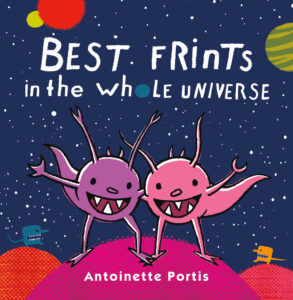
Kind of like Du Iz Tak? but with a slight increase in English, this alien friendship story earns its humor stripes when it explains those little socially awkward moments like when you accidentally/on purpose bite off your best frint’s tail.
Dylan the Villain by K.G. Campbell
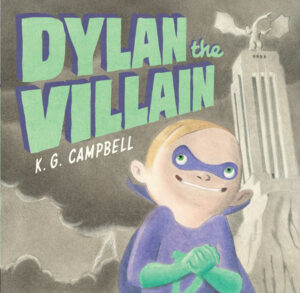
First off, I love that in this world, villainy is genetic but is capable of skipping generations. Second, I love that our anti-hero’s antagonist is a girl with a killer purple eyepatch. Having super villains as heroes isn’t a new idea in the movies, but in picture books it doesn’t happen all that often. I, for one, am hoping for more Dylan in the future.
The Happiest Book Ever! by Bob Shea

Every book should have a frog in it. There’s a lot of happy happy joy joy to this book mixed with a tincture of Monty Python. Could you ask for anything more?
A Hungry Lion by Lucy Ruth Cummins
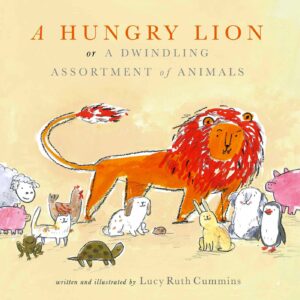
The subtitle, which is distinctly Edward Gorey-esque, gives you an indication of what kind of funny book this is. You know what it reminds me of? The movie Alien. And, naturally, the turtle is Ripley. Oh, like you hadn’t considered it before.
I Don’t Want To Be Big by Dev Petty, ill. Mike Boldt
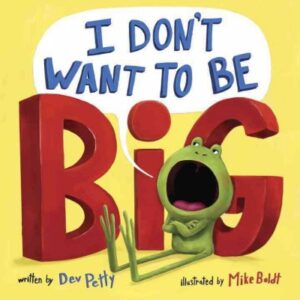
I didn’t bother to do this with any of the other books on this list, but for this one, I wanted to show you my favorite gag. The idea is that the frog is arguing that growing up is a bum rap. His dad tries to come up with reasons why it should still be done. So we get this:
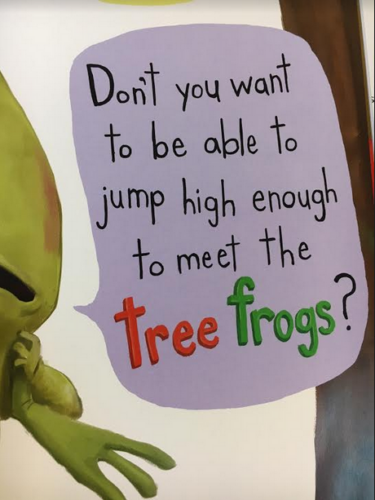
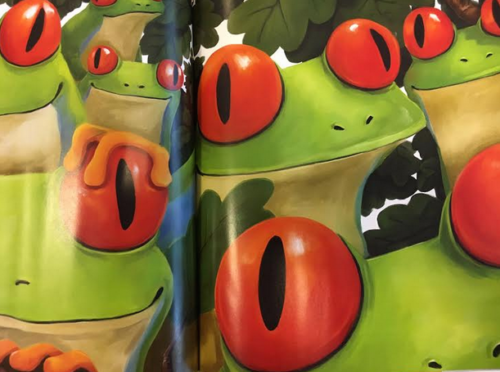
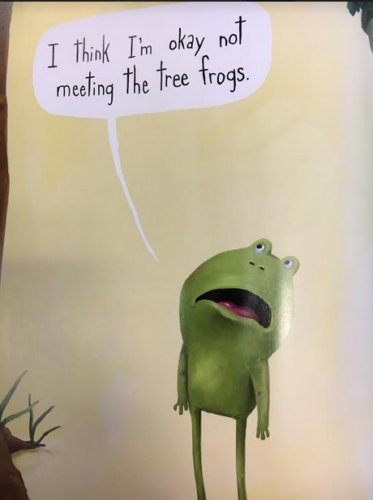
The defense rests, your honor.
Is That Wise Pig? by Jan Thomas
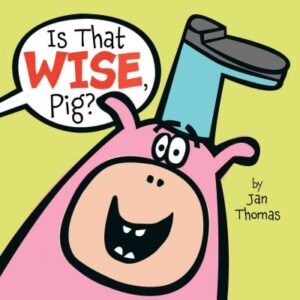
I mean, there’s a boot on that pig’s head. A boot! Just sayin’.
King Baby by Kate Beaton
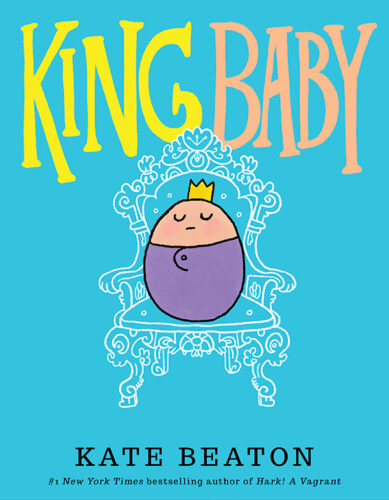
We’re getting there. Beaton’s starting out slow with her picture books. This one’s funnier than her last, and at the rate she’s going she should be able to make a perfectly Beaton-esque one soon. Though, to be frank, this next book on my list felt like Kate Beaton but not by Kate Beaton:
Leave Me Alone! by Vera Brosgol
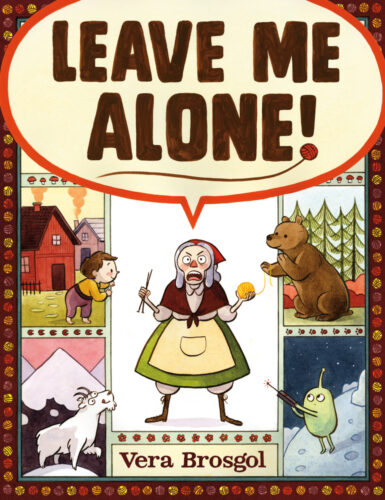
Did you notice that it appeared on the NPR Book Concierge for 2016? Did you notice who blurbed it? Ah, thank you. Ah, thank you.
Monsters Go Night-Night by Aaron Zenz
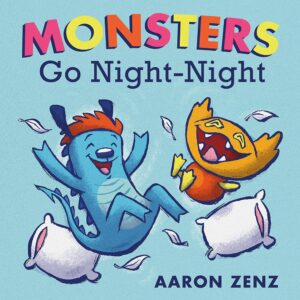
Proving yet again that I have the sense of humor of a 5-year-old. But let’s be frank. That potty joke? The best misdirection I’ve seen on a page in a long time.
Next to You: A Book of Adorableness by Lori Haskins Houran, ill. Sydney Hanson
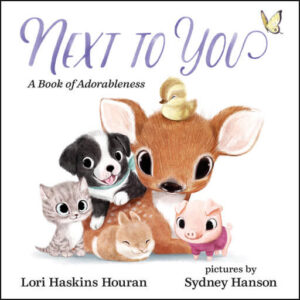
I’m going to stand by this one as a humor book. It throws you off with its big-eyed animals and then you get the snarky text. Seriously funny.
Oh No, Astro! by Matt Roeser, ill. Brad Woodard
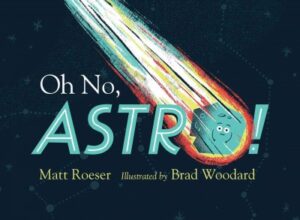
Proof positive that you can be a funny book and a visually stunning one all at the same time.
Penguin Problems by Jory John, ill. Lane Smith
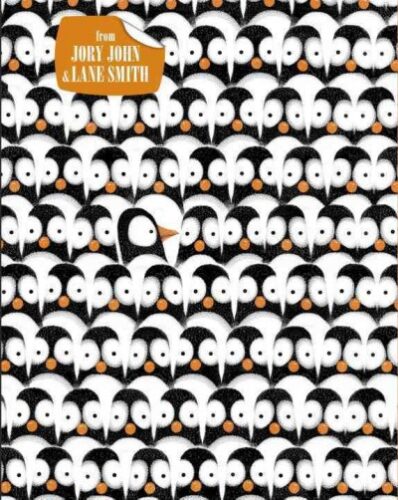
Misanthropic penguins make for comedy gold. Every good author worth his or her salt knows that.
Poor Little Guy by Elanna Allen
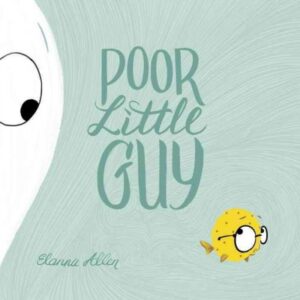
Of all the books on my list today, I worry that this one is the most underrated. Did you ever get a chance to read it? I feel like it got buried under a lot of other publications, but for sheer visual storytelling and gags it’s an out-and-out winner. I. Just. Love. It. Love it, love it, love it.
President Squid by Aaron Reynolds, ill. Sara Varon
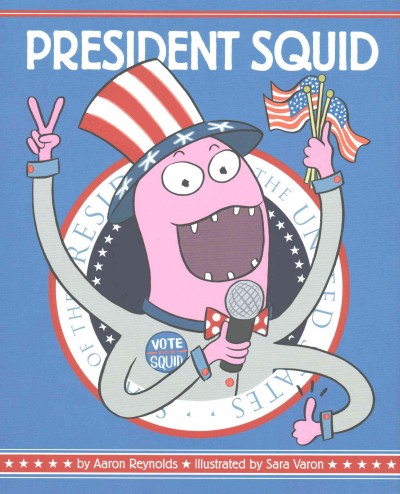
Okay. Your mission, should you choose to accept it, is to watch this video at the 18:30 mark. That’s when Aaron reads from his book and it’s the funniest reading ever you did see.
Pug Man’s 3 Wishes by Sebastian Meschenmoser
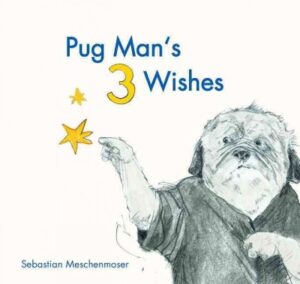
He’s the funniest German picture book author/illustrator of all time. Granted, the competition may not be particularly intense . . .
Quit Calling Me a Monster! by Jory John, ill. Bob Shea
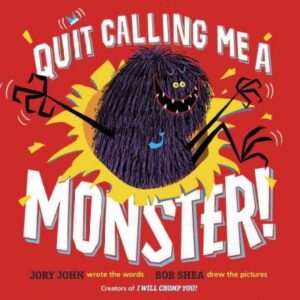
Both Jory and Bob are on this list twice. And I’d take off one of their books apiece, honest I would, if it weren’t for the fact that the monster in this book is named Floyd Patterson. I mean, I’m only human, after all.
Super Happy Magic Forest by Matty Long
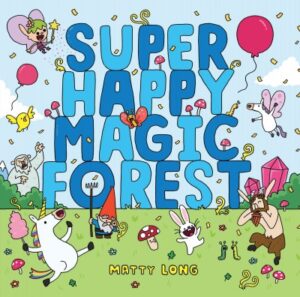
2016 was a good year for picture books making fun of fantasy tropes. I honestly think this book would appeal to any kid, though, regardless of their interest in swords and sorcery. Plus there’s a Gollum reference on one of the pages, so kudos there.
This is My Book by Mark Pett (and no one else)
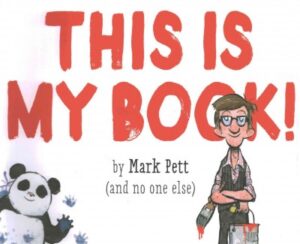
I almost swallowed my gum when I saw that the author of this book was Mark Pett. Pett? A subdued author/illustrator by and large, this book is a huge departure for him. A huge, hilarious departure. We could all use a mischievous panda in our lives.
A Voyage in the Clouds: The (Mostly) True Story of the First International Flight by Balloon in 1785 by Matthew Olshan, ill. Sophie Blackall
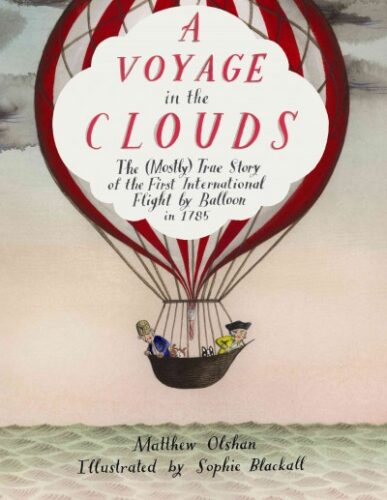
Somehow the fact that it’s all based on a true story (the iron vest, the peeing off the boat, the landing in their underwear, etc.) makes it all the funnier. Plus the fact that Ms. Sophie Blackall is in Funny Girl in 2017 is just the icing on the cake.
Who What Where? by Olivier Tallec
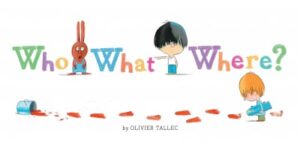
It’s a sequel but I don’t rightly care. It’s a hilarious sequel and may even improve upon the original.
Interested in the other upcoming lists of this month? Here’s the schedule so that you can keep checking back:
December 1 – Board Books
December 2 – Board Book Adaptations
December 3 – Nursery Rhymes
December 4 – Picture Book Readalouds
December 5 – Rhyming Picture Books
December 6 – Alphabet Books
December 7 – Funny Picture Books
December 8 – Calde-Nots
December 9 – Picture Book Reprints
December 10 – Math Picture Books
December 11 – Bilingual Books
December 12 – International Imports
December 13 – Books with a Message
December 14 – Fabulous Photography
December 15 – Fairy Tales / Folktales
December 16 – Oddest Books of the Year
December 17 – Older Picture Books
December 18 – Easy Books
December 19 – Early Chapter Books
December 20 – Graphic Novels
December 21 – Poetry
December 22 – Fictionalized Nonfiction
December 23 – American History
December 24 – Science & Nature Books
December 25 – Transcendent Holiday Titles
December 26 – Unique Biographies
December 27 – Nonfiction Picture Books
December 28 – Nonfiction Chapter Books
December 29 – Novel Reprints
December 30 – Novels
December 31 – Picture Books


By:
Betsy Bird,
on 8/5/2016
Blog:
A Fuse #8 Production
(
Login to Add to MyJacketFlap)
JacketFlap tags:
Best Books of 2016,
2016 picture books,
2016 reviews,
Reviews 2016,
2016 funny books,
2016 funny picture books,
Reviews,
picture books,
knitting,
funny books,
Roaring Brook,
Best Books,
macmillan,
funny picture books,
Vera Brosgol,
Add a tag
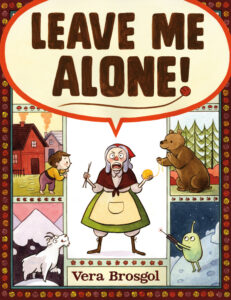 Leave Me Alone!
Leave Me Alone!
By Vera Brosgol
Roaring Brook Press (an imprint of Macmillan)
$17.99
ISBN: 9781626724419
Ages 4-7
On shelves September 13th
Knitting. It shouldn’t be so hard. I say this as the grown daughter of a chronic knitterer (not a word). I grew up neck deep in roving. I know the difference between a gossip wheel and a walking wheel (these are different spinning wheels). I know that if you want a permanent non-toxic dye for wool you use Kool-aid, that wool straight from the sheep is incredibly oily, and that out there are people who have turned the fur of their dogs and cats into sweaters. Yet the simplest act of knitting is lost on a good 50% of the children’s book illustrators out there that year after year can’t even be bothered to figure out which way the knitting needles are supposed to go. Down, people. The ends go down. In 2016 alone we’ve seen books like Maggie McGillicuddy’s Eye for Trouble get it wrong. Fortunately 2016 has also seen correctly positioned needles in Cat Knit, Ned the Knitting Pirate, and the greatest knitting related picture book I’ve seen to date Leave Me Alone! A superb readaloud of unparalleled visual humor, this is a knitting picture book par excellence and a pretty darn good original folktale too, come to think of it. Allowing for the occasional alien, of course.
“Once there was an old woman. She lived in a small village in a small house . . . with a very big family.” And by big family we mean big extended family. One gets the feeling that all her grown kids just sort of dump their own children on her, because there are thirty small grandchildren running amok in her home. Winter is coming soon and the old woman is keen on getting some knitting done for her extended brood. Trouble is, knitting and small children do NOT mix. So she picks up her stuff and goes into the deep, dark forest. That’s where the bear family finds her. So she goes to the mountains. Where the goats find her. Next it’s the moon. Where curious aliens find her. That leaves a wormhole where the void turns out to be her saving. Only problem is, it’s lonely in the void. Once her work is done, she heads back and when she sees her grandkids again, she doesn’t have to say a single word.
Here is the crazy thing about this book: It’s Vera Brosgol’s first picture book. I say that this is crazy because this does not read like a debut. This reads like Brosgol has been churning out picture books for decades, honing her skill, until finally at long last she’s produced a true diamond. But no. Some people get all the talent apparently. This is not, I should not, Ms. Brosgol’s first book in general. Her graphic novel Anya’s Ghost got a fair amount of attention a couple of years ago, and it was good. But nothing about that title prepared me for Leave Me Alone! Here we have a pitch perfect combination of text and image. If you were to read this book to someone without mentioning the creator, I don’t think there’s a soul alive who wouldn’t assume that the author and illustrator are one and the same. This is due largely to the timing. Just open the book to the first page. Examine the old woman on that page. Turn the page. Now look how that same woman has been transposed to a new setting and her expression has changed accordingly. Basically this sold the book to me right from the start.
 Funny picture books. For an author, creating a picture book that is funny means doing two things at once. You must appeal to both children and parents with your humor at the same time. Do you know how hard that is? Making something that a five-year-old thinks is funny that is also humorous to their parental unit is such a crazy balancing act that most picture book creators just fall on one side of the equation or the other. Make it funny only to adults and then you may as well just forget about the kids altogether (see: A Child’s First Book of Trump). Opt instead to only make it funny to kids and you doom the grown-ups to reading something they’d rather eat hot nails than read again (see: Walter the Farting Dog). But I honestly believe Brosgol has found the golden mean. Both adults and kids will find moments like the older sister stuffing a yarn ball in her brother’s mouth or the presence of the samovar (even in a wormhole) or the bear tentatively touching its nose after the old woman’s vigorous poke very funny indeed.
Funny picture books. For an author, creating a picture book that is funny means doing two things at once. You must appeal to both children and parents with your humor at the same time. Do you know how hard that is? Making something that a five-year-old thinks is funny that is also humorous to their parental unit is such a crazy balancing act that most picture book creators just fall on one side of the equation or the other. Make it funny only to adults and then you may as well just forget about the kids altogether (see: A Child’s First Book of Trump). Opt instead to only make it funny to kids and you doom the grown-ups to reading something they’d rather eat hot nails than read again (see: Walter the Farting Dog). But I honestly believe Brosgol has found the golden mean. Both adults and kids will find moments like the older sister stuffing a yarn ball in her brother’s mouth or the presence of the samovar (even in a wormhole) or the bear tentatively touching its nose after the old woman’s vigorous poke very funny indeed.
And let’s not downplay the writing here. There is serious readaloud potential with this book. I’ll level with you. In a given year you’ll see hundreds and hundreds of picture books published. Of these, a handful make for ideal readalouds. I’m not talking about books a parent can read to a child. I’m talking about books you can read to large groups, whether you’re a teacher, a librarian, or some poor parental schmuck who got roped into reading aloud to a group of fidgeting small fry. Few books are so good that anyone and everyone can enrapture an audience with them when read out loud. But Leave Me Alone! may be one of those rare few. Those beautiful butterflies. Those little jewels. The language mimics that of classic folktales, bandying about phrases like, “deep, dark forest”. And there are so many interactive possibilities. You could teach the kids how to yell out the phrase “Leave me alone!” all together at the same time, for example.
 As for the art, it’s perfect. There’s a kind of Kate Beaton feel to it (particularly when babies or goats have full balls of yarn stuffed into their mouths). As I mentioned before, Brosgol knows which way knitting needles are supposed to lie, and better still she knows how to illustrate thirty different, and very realistically rendered sweaters, at the story’s end. There are also some clever moments that you’ll notice on a third or fourth read. For example, the very first time the woman yells, “Leave me alone!” she’s exiting the gates to her home and her children’s homes. The only people who hear her are her grown children, which means we don’t have to worry about small ears hearing such a caustic phrase from their grandma. Smart. And did you see that the twins get identical sweaters at the end of the book? Finally, there are the visual gags. The goats that surreptitiously followed the old woman to the moon, nibbling on a moon man’s scanner, for example.
As for the art, it’s perfect. There’s a kind of Kate Beaton feel to it (particularly when babies or goats have full balls of yarn stuffed into their mouths). As I mentioned before, Brosgol knows which way knitting needles are supposed to lie, and better still she knows how to illustrate thirty different, and very realistically rendered sweaters, at the story’s end. There are also some clever moments that you’ll notice on a third or fourth read. For example, the very first time the woman yells, “Leave me alone!” she’s exiting the gates to her home and her children’s homes. The only people who hear her are her grown children, which means we don’t have to worry about small ears hearing such a caustic phrase from their grandma. Smart. And did you see that the twins get identical sweaters at the end of the book? Finally, there are the visual gags. The goats that surreptitiously followed the old woman to the moon, nibbling on a moon man’s scanner, for example.
I’ve seen a fair amount of hand wringing over the years over whether or not a children’s book can contain a protagonist that is not, in fact, a child, an animal, or an inanimate object rendered animate. Which is to say, are children capable of identifying with adults? More precisely, an adult who just wants to be alone for two seconds? The answer is swift and sure. Certainly they can. Particularly if the kid reading this book is an older sibling. The concept of being alone, of craving some time for one’s own self, is both familiar and foreign to a lot of kids. I’m reminded of the Frog & Toad story “Alone” from Days With Frog and Toad where Toad has a dark morning of the soul when he learns that Frog would like to have some alone time. Because of all of this, we see a lot of picture books where a character wants to be alone, has difficulty getting that “me time”, and eventually decides that companionship is the way to go (Octopus Alone, A Visitor for Bear, etc.). A few celebrate the idea (All Alone] by Kevin Henkes) but generally speaking parents use these books to convince their perhaps less than socially adept children that there are benefits to the concept of friendship. And there is a place in the world for such books. Fortunately there is also a place in the world for this book.
Folks sometimes talk to me about current trends in picture books. Sometimes they’re trying to figure out what the “next big thing” might be. But of course, the best picture books are the ones that at their core don’t really resemble anything but themselves. Leave Me Alone! isn’t typical. It reads aloud to big crowds of kids with great ease, lends itself to wonderful expressions, pops off the page, and will make anyone of any age laugh at some point. It’s a great book, and if I have to write another 500 words to convince you of it, I can do so. But why delay you from seeing it any longer? Go. Seek. Find. Read. Savor.
On shelves September 13th.
Like This? Then Try:
Source: Galley sent by publisher for review.
Misc: Cute promotion or THE CUTEST PROMOTION? As you can see from this Bustle interview, Ms. Brosgol knit twenty-five teeny tiny sweaters to promote this book. I steal the image for my own nefarious purposes and show it to you here:



By:
Betsy Bird,
on 5/25/2016
Blog:
A Fuse #8 Production
(
Login to Add to MyJacketFlap)
JacketFlap tags:
picture books,
Albert Whitman and Company,
funny picture books,
Lori Haskins Houran,
2016 picture books,
2016 reviews,
Reviews 2016,
Sydney Hanson,
Reviews,
Add a tag
 Next to You: A Book of Adorableness
Next to You: A Book of Adorableness
By Lori Haskins Houran
Illustrated by Sydney Hanson
Albert Whitman & Co.
$16.99
ISBN: 9780807556009
Ages 4-7
On shelves now
Years ago I saw a very interesting sketch produced during the early years of Disney animated filmmaking. The drawing was an explanation to animators on the precise proportions it takes to make a drawn character “cute”. The size of the eyes, the proportions between a large head and small hands, the slant of the gaze, all this contributes to the final cute form. At its worst, the word “cute” conjures up creations like those Precious Moments figurines and their insipid equals. At its best, it touches on our maternal and paternal instincts, even if we’re the kinds of folks who prefer furry animals to actual human babies. If you are a children’s librarian working with picture books, you get a nice and steady influx of cute into your location. Some of it is good, but most of it is fairly intolerable. An Anne Geddes / Nancy Tillman-like excess. I can be forgiven then for putting aside Next to You: A Book of Adorableness when first it came to my desk. I read every picture book I’m sent, but some I read a little faster than others, and this didn’t strike me as something to rush over and devour. It took a fellow co-worker to break the news to me that author Lori Haskins Houran’s title has a very sharp tongue lodged firmly in its cheek. With a canniness uncommon in cutesy picture book fair, Next to You manages to reach a dual readership: People who will take it seriously and people who will get the joke. Sweet.
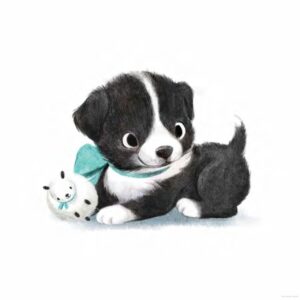 A narrator addressing a child sets the tone at the start. That tiny border collie puppy with the bow around its next and a little lamb toy (nice touch)? It’s only “kind of cute”. The yawning tiger cub or round-tailed bunny? “Whatever”. Honestly, the person being addressed wipes the floor with the competition. Those animals used to be really cute. “Until you came along. Now? Sorta so-so”. The narrator’s casual attitude is swiftly called into question, however, when they see a newborn giraffe for the first time. Seeing the giraffe chasing a butterfly, they’re almost persuaded that the giraffe is cuter but, “No! NO WAY! They are NOT as adorable as you. Not NEARLY.” Whew! A final shot of some of the animals in a cuddly pile ends with the narrator saying that none of them are as cute as you, “And you know what? I’m happy to be . . . next to you.” Aw.
A narrator addressing a child sets the tone at the start. That tiny border collie puppy with the bow around its next and a little lamb toy (nice touch)? It’s only “kind of cute”. The yawning tiger cub or round-tailed bunny? “Whatever”. Honestly, the person being addressed wipes the floor with the competition. Those animals used to be really cute. “Until you came along. Now? Sorta so-so”. The narrator’s casual attitude is swiftly called into question, however, when they see a newborn giraffe for the first time. Seeing the giraffe chasing a butterfly, they’re almost persuaded that the giraffe is cuter but, “No! NO WAY! They are NOT as adorable as you. Not NEARLY.” Whew! A final shot of some of the animals in a cuddly pile ends with the narrator saying that none of them are as cute as you, “And you know what? I’m happy to be . . . next to you.” Aw.
Okay. So let’s talk audience here. When a picture book is talking about how cute someone is, that’s usually a tip-off that kids aren’t actually the focus. Instead, this is probably a book written with the hopes of becoming a baby shower staple. Picture books for expectant mothers are big business (how else to explain the inexplicable yet continual sales of Love You Forever?) so each season we see a couple titles make a play for the hearts and minds of incipient parents everywhere. Few succeed in the long run. What distinguishes Next to You from the pack is that it manages to not merely be a new baby book. Houran has somehow or other managed to write something that has appeal to a certain brand of snarky new parent (a common animal too often ignored by the picture book market) AND to actual children as well. This book is self-aware. A saving grace.
 The text gets you pretty much from the first sentence onward. “Next to you, the softest puppy in the world is only kind of cute.” As a librarian I was intrigued but I wasn’t sold. Not until we got to the squirrel. That was the moment when I felt like Houran was making a distinct comment about those of us that waste countless hours watching cute animal videos on YouTube. “A squirrel eating a doughnut with his tiny hands? Adorable, sure. But next to you? Meh. Just OK.” The mix of “tiny hands” and “meh” is noteworthy. I know this sounds a little odd, but that two-page spread is the first true indication that you’re dealing with a picture book is a slick sense of humor. After all, that opening line might just be a fluke. But there is no denying how funny squirrels with itty-bitty widdle hands are, particularly when combined with the all-encompassing and supremely uninterested, “meh”. When the book stops for a moment to goggle at the shockingly cute giraffe, that pause is fascinating. I mean, how do you get a plot out of a book where all the narrator is saying is how cute various animals are? Houran must have also had a blast trying to conjure up all the different forms of cuteness out there? At the same time, take some care to notice that these animals are never in compromising positions. A pig may occasionally wear a sweater but nothing here is considered cute because it’s having its dignity taken away.
The text gets you pretty much from the first sentence onward. “Next to you, the softest puppy in the world is only kind of cute.” As a librarian I was intrigued but I wasn’t sold. Not until we got to the squirrel. That was the moment when I felt like Houran was making a distinct comment about those of us that waste countless hours watching cute animal videos on YouTube. “A squirrel eating a doughnut with his tiny hands? Adorable, sure. But next to you? Meh. Just OK.” The mix of “tiny hands” and “meh” is noteworthy. I know this sounds a little odd, but that two-page spread is the first true indication that you’re dealing with a picture book is a slick sense of humor. After all, that opening line might just be a fluke. But there is no denying how funny squirrels with itty-bitty widdle hands are, particularly when combined with the all-encompassing and supremely uninterested, “meh”. When the book stops for a moment to goggle at the shockingly cute giraffe, that pause is fascinating. I mean, how do you get a plot out of a book where all the narrator is saying is how cute various animals are? Houran must have also had a blast trying to conjure up all the different forms of cuteness out there? At the same time, take some care to notice that these animals are never in compromising positions. A pig may occasionally wear a sweater but nothing here is considered cute because it’s having its dignity taken away.
It’s a lucky editor that gets a manuscript like this one. Imagine knowing that the artist you acquired would have to excel in the art of “cute”. This editor undoubtedly had to consider a wide swath of artists adept at big eyes and tiny bodies. In the end, the selection fell to first time picture book illustrator Sydney Hanson. Trained in animation and character design, Hanson’s Tumblr page is awash in a sea of sweetness. More details and intricate than the characters found in this book, Hanson is adept at not simply rendering cute the horrible (the big-eyed tarantula is my favorite) but making it clear that these characters have personalities too. The book doesn’t give away Hanson’s medium, so this might all be done on a computer for all I know. That said, it looks like colored pencils. For the art to be effective there has to be a certain level of fuzziness to it. Colored pencils provide that virtual fuzz. My two-year-old son has taken to hugging cute characters in books when he sees them. Next to You, thanks to Hanson’s techniques, is now infinitely huggable.
I never thought I’d say this, but I think this book would actually make a good readaloud to a large group. It would take some practice. You’d really have to get your cadences down. But with the right inflection this could actually work for a bunch of kids. It might even work particularly well for those of the jaded variety. The same kinds of kids that get hornswaggled by Guess Again! by Mac Barnett and Adam Rex would find themselves flummoxed by this book. Few can turn pages without thinking, “Where is this going?” An oddity of a book, but a good one to know about. Don’t let the big blue kitten eyes on the cover fool you. There’s a lot to love between these pages. It’s a book that upsets expectations for adults but still manages to be fun for kids. And if you happen to want to give it to a new parent, I’m not gonna stop you. Not one little bit.
On shelves now.
Like This? Then Try:


By:
Betsy Bird,
on 1/7/2016
Blog:
A Fuse #8 Production
(
Login to Add to MyJacketFlap)
JacketFlap tags:
Reviews,
Best Books,
funny picture books,
Sebastian Meschenmoser,
German children's books,
translated picture books,
NorthSouth Books,
German imports,
Best Books of 2016,
2016 imports,
2016 picture books,
2016 reviews,
Add a tag
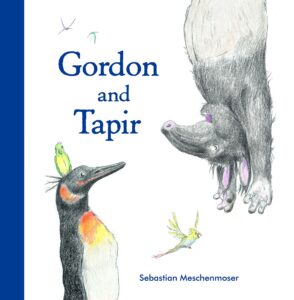 Gordon and Tapir
Gordon and Tapir
By Sebastian Meschenmoser
North/South Books
$18.95
ISBN: 9780735842199
Ages 3-6
On shelves April 1, 2016
There is a perception here in America about the Germans. It is a firm belief that, as a nation, they are devoid of a sense of humor. Americans love to bring this up. I’m not sure what they’re trying to prove necessarily when they say it, but the idea has been repeated so often that few would bother to contest it. Can you name any German stand-up comics? How about funny imported German films? What about funny German picture books? AH HA! There I’ve got you. Because while I cannot pull out of a hat any comics or movies, what I can do is show you without a sliver of a doubt that thanks to picture books like those of Sebastian Meschenmoser, we have absolute proof that Germans have a distinct and ribald sense of humor. With the release of his latest book in the States, Gordon and Tapir, Meschenmoser plumbs the Odd Couple concept with some distinctive twists of his very own. This is some primo German goofball stuff.
The book opens wordlessly. A penguin goes to his restroom with a newspaper. He reaches for the toilet paper. But what is this? Someone’s used it all up. And not just anyone. The penguin, who goes by the name of Gordon, stamps down the hall to his roommate Tapir’s room. Inside he finds the animal reclining in a toilet paper constructed hammock, an elaborate fruit cup in hand and a headdress that would wow Carmen Miranda on his noggin. Immediately Gordon launches into a litany of transgressions Tapir has engaged in. The floor’s sticky with fruit, the dishes are never done, and why exactly has there been a hippo living in the bathtub for the past few days? Tapir isn’t taking this lying down. He has his own complaints, like why does EVERYTHING have to be so neat and tidy? Why does the garbage have to stink of fish all the time? And why can’t Tapir join Gordon’s all-penguin club? Eventually, Gordon moves out and once Tapir discovers this he gives the bird a call. Turns out, it is a fantastic solution. Now Tapir can be dirty, Gordon can be neat, but they can visit each other and be friends again far better than if they lived together. Happy endings for all.
I’ve always carried the torch for Meschenmoser’s art. From his sleepless animals in Waiting for Winter to his previous penguin dip into surrealism in Learning to Fly the man has a strange kinship with the furry and feathery. So much of the character development in these tales comes from their body language. For example, there’s a spread in this book where Gordon lies in bed on his back staring at the ceiling at 3 a.m. while Tapir does much the same thing, albeit blearily, in his own room. This is followed by a silent film of sorts where Gordon finds a new place to stay in the paper and takes off as Tapir hears the door open and looks up with just the saddest expression in his eyes. Any picture book that dares to go silent for an extended amount of time in the center of the story is being gutsy. It’s not easy to pull off, and Meschenmoser ups the ante (as it were) by rendering everything during those wee hours of the morning in black and white graphite sketches.
 Then there are the little visual details and gags. The humor is sublime here. Meschenmoser is just as comfortable with silent gags (remember, this is coming from the man who made Charlie Chaplin references in the images of Mr. Squirrel and the Moon) as he is with words. Some of the jokes are there for the parents doing the reading. Did you notice the tapir in a bathing suit that bedecks the inside bathroom door? Or the fact that when Gordon stomps from the bathroom to Tapir’s room the wallpaper goes from a pristine fish pattern to paper that’s torn and peeling in large chunks? Did you see that the little cactus that Tapir gives to Gordon as a housewarming present is sitting on his dresser earlier in the book? And did you know that every single one of Gordon’s penguin friends is based on a famous author? I’ve good money riding on the fact that one of them resembles Sigmund Freud. I loved that Gordon has a goldfish swimming in his party drink (a tasty treat for later?). And so tiny you’d probably miss them but worth it every time I notice them is this: mongooses in teeny tiny colorful party hats. Life is sweeter because they are there.
Then there are the little visual details and gags. The humor is sublime here. Meschenmoser is just as comfortable with silent gags (remember, this is coming from the man who made Charlie Chaplin references in the images of Mr. Squirrel and the Moon) as he is with words. Some of the jokes are there for the parents doing the reading. Did you notice the tapir in a bathing suit that bedecks the inside bathroom door? Or the fact that when Gordon stomps from the bathroom to Tapir’s room the wallpaper goes from a pristine fish pattern to paper that’s torn and peeling in large chunks? Did you see that the little cactus that Tapir gives to Gordon as a housewarming present is sitting on his dresser earlier in the book? And did you know that every single one of Gordon’s penguin friends is based on a famous author? I’ve good money riding on the fact that one of them resembles Sigmund Freud. I loved that Gordon has a goldfish swimming in his party drink (a tasty treat for later?). And so tiny you’d probably miss them but worth it every time I notice them is this: mongooses in teeny tiny colorful party hats. Life is sweeter because they are there.
But for all that, the real reason I loved this book as much as I did was that the lesson I took away from it wasn’t American in the slightest. Imagine if a Yank tried writing the same book. Gordon and Tapir would have their differences. They’d have their fight. They’d both spend a sleepless night. Then the next morning Gordon would make a concession, Tapir would make a concession, and they’d work out their differences. And there is nothing wrong with a book about meeting someone halfway. Yet what I loved so much about this book was the fact that it eschewed every rote picture book plot I’d come to expect and went in an entirely new direction. Because honestly, let’s face it, sometimes friends are NOT meant to live together. Couples grow apart, people change, and there are times when you are much closer to someone if they don’t share the same space that you do 24/7. Meschenmoser makes it crystal clear that Gordon and Tapir’s friendship is stronger when Gordon leaves. Now I’m sure some folks will read this as a “stick with your own kind” narrative (after all, tapirs and penguins don’t even occupy the same temperate zones) but I’d argue that their friendship belies that. It isn’t that they don’t vastly enjoy each other’s company. They just need their own personal space at the end of the day, and that is absolutely 100% a-okay.
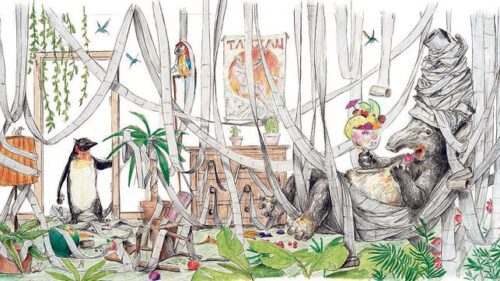 As crazy as it sounds, this actually wouldn’t be the worst picture book to hand to a small child with parents going through a divorce. I think it’s pretty clear from the book that sometimes you have nothing in common with the person you’re living with and that it’s best for all parties if a split is made. I don’t think the book was written with that intention in mind, and that is probably why it would work particularly well. There isn’t any didacticism to plow through. Just good storytelling
As crazy as it sounds, this actually wouldn’t be the worst picture book to hand to a small child with parents going through a divorce. I think it’s pretty clear from the book that sometimes you have nothing in common with the person you’re living with and that it’s best for all parties if a split is made. I don’t think the book was written with that intention in mind, and that is probably why it would work particularly well. There isn’t any didacticism to plow through. Just good storytelling
There’s a long history of funny German children’s literature that leads directly to Mr. Meschenmoser. Remember that this is the country where Der Struwwelpeter came to light (though its humor is a bit of an acquired taste). And alongside fellow contemporary funny German picture book artists like Torben Kuhlmann and Ole Konnecke he’s in good standing. With any luck we’ll be seeing more of their books coming to U.S. shores in the coming years. So who knows? Maybe if we get enough Gordon and Tapir types of books the humorless perception of the German people will undergo a change. At the very least, we’ll get some magnificent stories out of the deal. This one’s a keeper.
On shelves April 1st.
Source: Galley sent from publisher for review.
Like This? Then Try:

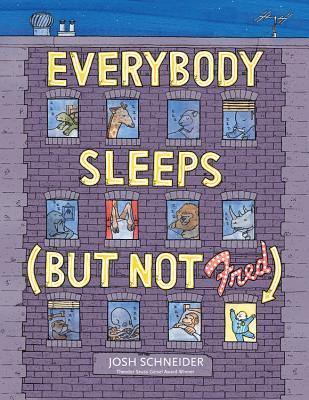 Everybody Sleeps (But Not Fred)
Everybody Sleeps (But Not Fred)
By Josh Schneider
Clarion Books (an imprint of Houghton Mifflin Harcourt)
ISBN: 978-0544339248
Ages 4-6
On shelves April 7, 2015
When attempting to turn small writhing human beings of very little years into mature, forthright, sterling individuals of singular merit and good humor we run into some challenges. There’s teaching them to eat their dinner (even the vegetables). There’s endowing them with an appreciation of tooth brushing. And then there’s the trickiest one of all: bedtime. That moment every day is when the battle of wills must begin. Now for some kids bedtime is merely a nightly inconvenience. For others, a call to arms. It is where our children pull out all the stops and use every last bit of intelligence and cunning at their disposal in the hopes of avoiding the unavoidable. Many is the picture book that has tried to bring that struggle to life on the page. Most catalog avoidance techniques. That is understandable. Like I say, creativity flows like a gushing torrent when kids are trying to get out of sleepytime. But one, a certain Everybody Sleeps (But Not Fred), goes a different route entirely. In this book Fred isn’t just avoiding bedtime. He’s making it nigh well impossible for anyone else to get any shut-eye either. Funny? You don’t know the half of it.
In this book Schneider takes the usual bedtime avoidance metaphors and then proceeds to crank them up to eleven. It’s bedtime. A time when all the animals are getting some well-deserved rest. There are the sheep counting themselves down. There are the monkeys, dreaming of some fine ballet antics. There are the monsters, brushing their teeth before they go down. And then, there is Fred. A Fred, who is not taking any of this lying down. He has a list of things to get done and by golly he’s going to do them. He might be playing loud instruments on the one hand or searching for Bigfoot on the other. Whatever it is he does, he does it loudly and all the animals are having a heckuva time getting some slee . . . wait! What’s this? It looks like Fred is sleeping at last. What a relief! But close the book quietly or he might begin his antics all over again.
So I’m just sitting here waiting for Josh Schneider to do something wrong. Any minute now. Any minute. Surely it’s just a matter of time before he pens a dud, right? Because as of right now in the year 2015 he’s just been hitting it out of the park over and over again. Tales for Very Picky Eaters won itself a Geisel Award. The Meanest Birthday Girl is the best white elephant tale you’ll ever pick up. And Princess Sparkle-Heart Gets a Makeover has to be the best Frankenstein meets pretty pretty princess fare you’ll run ever run across. So even though the cover of this book made me laugh out loud on sight (the giraffe takes up two floors!!!) I tried to read Everybody Sleeps (But Not Fred) with an open mind. Schneider was going to have to earn my love with this one. Yeah, he pretty much does that from page one onwards.
Part of this has a lot to do with Schneider’s love of detail. His is not a changeable illustration style. Once again he employs the same thin black lines. The same L’il Orphan Annie’s pupil-less eyes. But here he’s been given a bit more leeway with the art. I don’t know that I ever felt he was holding himself back before, but if this book is any indication then yes. Yes he has. This is a book that rewards the parent called upon to read and reread certain sections multiple times. Some examples: Turn now to the page where the sheep are getting sleepy. Did you notice that there’s a tally on the wall and that next to one of the tally marks they’ve written a sheep’s name with a question mark? Clearly they’re good at keeping track. And did you notice that the animals that move from page to page are actually Fred’s stuffed animals seen at the beginning and end of the book? This only becomes perfectly clear when you get to the end and the woebegotten sheep Fred has fallen asleep upon turns into a stuffed animal with a mere page turn. Then you have to spend an inordinate amount of time flipping back through the book to figure out where each stuffed animal plays into the narrative.
Is it repetitive of me to mention that it’s funny to boot? Let us not downplay the role of humor in a title. If Schneider was truly told by his editor to go all out and do whatever he liked (which, regardless of whether or not that happened, is the overall impression anyway) you could not get a better mixture of child and adult humor. Some books tip too far in one direction or another. This book walks the fine line. So you’ll have monkeys performing ballet on the one hand (note that to accommodate their feet, Schneider has given their shoes a little extra hole for the superfluous thumb toe) and then you’ll have the text of the world’s most boring bedtime book on the other. At one point in the story we are told that a group of children has been bored into snores by the reading of a particularly draining bunny book. We even get a glimpse of the text and to my mind it is worth the price of the book right there. I won’t ruin it for you. Just know that “foreign monies” does in fact rhyme with “bunnies” and that this may be the first time the term “bunny bender” has ever appeared in any kind of a context in a children’s book.
All this is well and good, but let’s examine the really important part: how does the book read aloud? You see I have a three-year-old residing in my home right now and if a book doesn’t pass the readaloud test then this particular kiddo is not going to care two bits about Fred, sleeping or otherwise. Happily, it reads beautifully. I was able to have particular fun with the “but not Fred” part of each sequence. You just drop a long pause in there. Not so long it loses your audience, but long enough to build anticipation. Then you lean towards the kid and say sotto vox, “… but not Fred.” Gets ‘em every time, guaranteed.
Is it a book that will actually put a kid to sleep? Not in the traditional sense. I mean, you want soporific fare you may as well stick to Goodnight Moon. There is, however, the possibility that Fred’s antics will be so wild and wackadoodle that they’ll exhaust your own child by mere association. And, of course, he’ll amuse them deeply. He and his dead tired animal/monster companions. There are books about avoiding going to bed and then there’s Fred. A book with a spring in its step, a song in its heart, and what appears to be Jolt Cola swimming through its veins. Sleepers awake!
On shelves April 7th.
Like This? Then Try:
Professional Reviews:


By:
Betsy Bird,
on 1/6/2015
Blog:
A Fuse #8 Production
(
Login to Add to MyJacketFlap)
JacketFlap tags:
Reviews,
Best Books,
funny picture books,
Ame Dyckman,
Zachariah Ohora,
Best Books of 2015,
Reviews 2015,
2015 picture books,
2015 reviews,
Add a tag
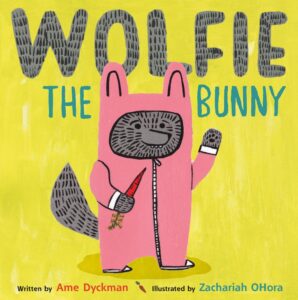 Wolfie the Bunny
Wolfie the Bunny
By Ame Dyckman
Illustrated by Zachariah OHora
Little, Brown and Co.
$17.00
ISBN: 978-0-316-22614-1
Ages 3-6
On shelves February 17th
Not every child views the imposition of a new sibling as an interloper, but a fair number of them do. They’re just tooling along, enjoying the natural bliss that comes with being the one and only star in their parents’ firmament when BLAMMO! A squalling person of inadequate size is there, hogging the attention. Unsurprisingly a low burn (or, in other cases, epic) rivalry erupts. Plenty of children’s books have addressed this issue, to varying degrees of success. It was then with great joy that I read one of the finest the other day. Wolfie the Bunny by Ame Dyckman may look, at first glance of the cover, like a lupine variation on that bunny suit worn by Ralphie in A Christmas Story but inside you will instead find a delightful tale of sibling rivalry as well as a cautionary tale of the dangers that come when shopping at a Brooklyn co-op. Issues every child should certainly be made aware of.
If you are a bunny and your parents find that a baby wolf has been left on their stoop, you would be well within your rights to have some qualms. But when Dot’s Mama and Papa first lay eyes on little Wolfie, all tucked tight into his little basket, it’s love at first sight. Not so Dot, who declares with refreshing candor, “HE’S GOING TO EAT US ALL UP!” Her protestations, however, fall on deaf ears. Next thing she knows, Dot has a little, toothy brother. He likes eating carrots for breakfast. He sleeps very well through the night. And he absolutely loves and adores his new big sister to the point where she can’t use the potty or color without Wolfie drooling all over her. Time passes and soon Wolfie’s a great big furry guy eating the family out of house and home. When he and Dot are dispatched to the nearby Carrot Patch Co-Op to pick up some additional grub, she is certain that this will be the moment he makes his predatorial move. However, when the chips are down and Wolfie finds himself in peril, it’s up to his big sister to swoop in and save the day.
In her Author’s Note at the back, Dyckman mentions that much of the inspiration for this book came from her daughter who, as a toddler, would occasionally “transform” into what they called a “Wolf Baby”. Yet in her story it’s Dot who’s the star of the show. For all that the book is called “Wolfie the Bunny”, Dot has the reader’s sympathies from the get go. Then, after you’re Team Dot for a while, Dyckman cleverly gives us a glimpse into Wolfie’s p.o.v. When Dot and her friends run off after they’ve screamed a customary “HE’S GOING TO EAT US ALL UP” we see baby Wolfie crying for the first time. It’s from that point on that Wolfie attaches himself to Dot like a saliva-producing shadow. To give the book the right sound when reading it aloud, Dyckman also adds a little gentle repetition into the text. Combating Dot’s war cry of Wolfie’s dining predilections are her father’s proud exclamations whenever Wolfie does pretty much anything at all. If Mama says he’s sleeping then Papa will note, “He’s a good sleeper”. If Dot complains about him drooling Papa says, “He’s a good drooler.” And back go your sympathies to Dot. It’s a delicate balance but Dyckman pulls it off.
And yet, for all that, you still might have difficulty seeing Wolfie as anything but a bloodthirsty bunny eater, were it not for the elegant stylings of artist Zachariah OHora. Having already cut his teeth on making 500-pound gorillas adorable (but not cute) in “No Fits, Nilson”, OHora’s thick acrylics are perfect for “Wolfie” here. He’s toothy, no question, but his eyes sport this wide-eyed innocence that’s hard to resist. Truth be told, you fall for him as thoroughly as Mama and Papa when you see him. All this is set against a limited color palette. Aside from mustard yellow, green, red, and pink, there really aren’t a lot of other colors. The thick black paints are abundant, and the colors are seemingly subdued, yet pop when required to do so.
Now generally speaking I have a problem with picture books where animals subsume their natural instincts. Books like Miss Spider’s Tea Party where the whole point is not to judge someone, even if they’re a spider that should, by all rights, be eating her guests. So I should probably be upset that Wolfie has somehow gone off his natural wolf instincts. Instead, I’m charmed. This is nature vs. nurture at its finest. Sure he’s drooling on Dot, but anyone who has ever witnessed a kid in the throes of teething will understand what that’s like. On the one hand you could argue that it is cruel to dress a wolf in a bunny suit, no matter how kindly the bunnies or sweet the wolf. On the other hand, this is clearly Wolfie’s choice. You get the distinct impression that the bunny suit might even have been his idea. So what does that say about the choices our children make, even when they don’t gel with society’s expectations? No idea. I just like the image of a wolf in a bunny suit. It’s funny.
It is difficult to estimate how many authors and illustrators of children’s literature live in Brooklyn, NY. General wisdom states that the borough contains the highest concentration of folks of that ilk in the country. Certainly every season we see a new crop of books that reference and work in little Brooklyn-based details and elements. The kicker is that the place exerts such a pull that even artists who have moved away can’t help but reference it. Such is the case with Zachariah OHora. As he mentions in his Artist’s Note, though he now lives in Pennsylvania, the setting of his book is his old Park Slope neighborhood. The co-op, his old co-op. And then when you look a little closer you see other Brooklynesque details. Mama and Papa, for example, are so hip it hurts. I mean just check out their collection of vintage cameras (they must have a basement full of Polaroid film). You just know they both are adept on the ukulele, brew their own beer, and go to art house films with the kids every Saturday morning. But I digress.
Who hasn’t looked at their younger brother or sister and thought at one time or another that they bore more in common with animals than people? Wolfie the Bunny isn’t really going to change their minds on that front. Nope. Instead it’s going to just strike them as amazingly funny. With its catchy refrains, stellar pictures, and original storyline, this is one of the more charming picture books out there. A great book. Personal sibling issues not required.
On shelves February 17th.
Like This? Then Try:
Source: F&G sent from publisher for review.
Professional Reviews:


By:
Betsy Bird,
on 7/21/2014
Blog:
A Fuse #8 Production
(
Login to Add to MyJacketFlap)
JacketFlap tags:
Reviews,
picture books,
Best Books,
Houghton Mifflin Harcourt,
Clarion Books,
funny picture books,
Josh Schneider,
Best Books of 2014,
Reviews 2014,
2014 picture books,
2014 reviews,
Add a tag
 Princess Sparkle-Heart Gets a Makeover
Princess Sparkle-Heart Gets a Makeover
By Josh Schneider
Clarion (an imprint of Houghton Mifflin Harcourt)
$16.99
ISBN: 978-0-544-14228-2
Ages 3-7
On shelves now
Sometimes I’ll just sit back and think about how the advent of the internet has affected literary culture. I don’t mean book promotion or reviews or any of that. I’m talking about the very content of books themselves. On the one hand, it accounts for the rise in Steampunk (a desire for tactile, hands-on technology, gears and all). On the other, it has led to a rise in books where characters make things. So why, you may be asking yourself, am I saying all this when ostensibly I’m supposed to be reviewing a picture book with the title Princess Sparkle-Heart Gets a Makeover? Because, best beloved, Josh Schneider has created a picture book that provides solutions. If something terrible happens to something you love, do you sit on the floor and cry and bemoan your fate? NO! You go out and find the solution, even if it means getting your hands a little dirty. We’re seeing a nice uptick in books where kids make things and fix things on their own. Add in a jealous doggy and a twist ending that NO ONE will see coming and you have a book that could easily have been written in the past but contains a distinctly 21st century flavor through and through.
Amelia just couldn’t be happier. When she gets her new doll, Princess Sparkle-Heart, the two bond instantly. They do tea parties, royal weddings, share secrets, the works. Never mind that Amelia’s pet dog eyes their happiness with an envious glare. The minute the two are separated, it acts. One minute Princess Sparkle-Heart is reading a book to herself. The next, she’s a pile of well-chewed bits and pieces on the floor. At first Amelia is distraught, but when her mother proposes putting the doll back together Amelia provides direction and ideas. This is the all-new Princess Sparkle-Heart, ladies and gentlemen. One that is NOT going to be taken advantage of again.
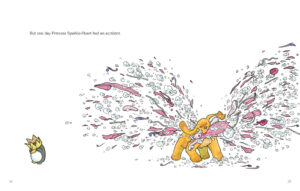 I’ll be the first to admit to you that I like a little weird with my children’s literature. The only question is whether or not kids like the same kind of weird that I like. There’s no question that some of them do have a taste for the unusual, after all. It’s adult selectors that grow disturbed by some of this author/illustrator’s choices. In the case of Princess Sparkle-Heart (can I tell you how much I love that her last name is hyphenated?) I’ve already seen a schism between some adults and others. Some adults find this book freakin’ hilarious. They love the odd way in which Schneider chooses to empower his heroine. Others aren’t amused in the least. For my part, I found it a wonderful new girl/doll story. I was particularly fond of the spread where Amelia looks at a wall of fashion magazines and zeroes in on the sole solitary superhero comic found there instead. So if Schneider is telling readers something, he’s being subtle about it.
I’ll be the first to admit to you that I like a little weird with my children’s literature. The only question is whether or not kids like the same kind of weird that I like. There’s no question that some of them do have a taste for the unusual, after all. It’s adult selectors that grow disturbed by some of this author/illustrator’s choices. In the case of Princess Sparkle-Heart (can I tell you how much I love that her last name is hyphenated?) I’ve already seen a schism between some adults and others. Some adults find this book freakin’ hilarious. They love the odd way in which Schneider chooses to empower his heroine. Others aren’t amused in the least. For my part, I found it a wonderful new girl/doll story. I was particularly fond of the spread where Amelia looks at a wall of fashion magazines and zeroes in on the sole solitary superhero comic found there instead. So if Schneider is telling readers something, he’s being subtle about it.
I’ve also been noticing a rather nice trend recently in books starring young girls. There’s a real movement in the country right now to give girls the impetus to make and create and build. Books like The Most Magnificent Thing by Ashley Spires where the heroine not only builds but deals repeatedly with disappointment are really quite fabulous. In Princess Sparkle-Heart Amelia’s unseen mother is the one doing the construction of a new princess, but it’s Amelia who provides the number of parts and the specifications. If the new princess is completely different from her prior incarnation, that’s thanks to Amelia’s contributions. Meanwhile the Frankenstein connection that some have noted (and that I entirely missed the first time around) is clearly intentional. How else to explain the two screws that appear in the “M” of the front cover’s “Makeover”? No doubt Princess Sparkle-Heart’s conversion will strike some as monstrous. For others, it’ll be like your average everyday superhero origin story. Nothing wrong with that!
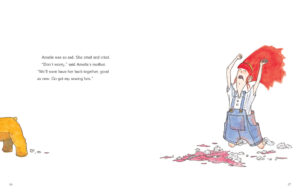 I’ve been oddly amused by dog books this year. I am not a dog person. I can take ‘em or leave ‘em. But in 2014 we’ve seen some really spectacular canine picture books. Things like Shoe Dog by Megan McDonald, and I’m My Own Dog by David Ezra Stein, and now this. The dog in this particular book is awfully similar to the one in Bears by Ruth Krauss as re-illustrated by Maurice Sendak, with its jealousy of a beloved toy. Cleverly Schneider has positioned the dog’s growls to serve as a running commentary behind the action. A low-key “GRRRRRRRRRR” runs both on and off the page, bleeding into the folds, falling off the sides. Schneider’s humans never have pupils (and combined with her red hair this gives Amelia a distant L’il Orphan Annie connection) but the dogs and stuffed animals do. As a result, the dog ends up oddly sympathetic in spite of its naughty ways (and indeed there is a happy ending for all characters at the story’s close).
I’ve been oddly amused by dog books this year. I am not a dog person. I can take ‘em or leave ‘em. But in 2014 we’ve seen some really spectacular canine picture books. Things like Shoe Dog by Megan McDonald, and I’m My Own Dog by David Ezra Stein, and now this. The dog in this particular book is awfully similar to the one in Bears by Ruth Krauss as re-illustrated by Maurice Sendak, with its jealousy of a beloved toy. Cleverly Schneider has positioned the dog’s growls to serve as a running commentary behind the action. A low-key “GRRRRRRRRRR” runs both on and off the page, bleeding into the folds, falling off the sides. Schneider’s humans never have pupils (and combined with her red hair this gives Amelia a distant L’il Orphan Annie connection) but the dogs and stuffed animals do. As a result, the dog ends up oddly sympathetic in spite of its naughty ways (and indeed there is a happy ending for all characters at the story’s close).
Occasionally folks will ask me for “Princess Book” recommendations. Admittedly I’m far more partial to subversive princess tales (The Paperbag Princess, The Princess and the Pig, etc.) than those that adhere to the norm. Keeping that in mind, this is definitely going into my princess book bag of tricks. With its twist ending, strong female character, and princess that looks like she could take down twenty monsters without a blink, I’m a fan. I wouldn’t necessarily hand it to the kid looking for fluff and fairies and oogly goo, but for children with a wry sense of humor (and they do exist) this book is going to pack a wallop. Funny and surprising and a great read through and through. You ain’t never seen a makeover quite like THIS before.
On shelves now.
Source: Galley sent from publisher for review.
Like This? Then Try:
- Bears by Ruth Krauss, illustrated by Maurice Sendak
Other Blog Reviews: Sal’s Fiction Addiction,
Professional Reviews: A star from Publishers Weekly, A star from Kirkus,
Misc: There is a TON of stuff related to the book on the publisher’s website. Everything from sewing patterns to a Q&A to early sketches to more more more!


By:
Betsy Bird,
on 6/12/2014
Blog:
A Fuse #8 Production
(
Login to Add to MyJacketFlap)
JacketFlap tags:
Reviews,
picture book,
picture books,
Simon and Schuster,
Atheneum,
Best Books,
funny picture books,
picture book readalouds,
Best Books of 2014,
Reviews 2014,
2014 picture book readalouds,
2014 picture books,
2014 reviews,
Add a tag
 Hug Machine
Hug Machine
By Scott Campbell
Atheneum (an imprint of Simon & Schuster)
$16.99
ISBN: 978-1-4424-593509
Ages 3-7
On shelves August 26th
Do you remember that old Shel Silverstein poem “Hug O’ War”? This may be considered sacrilege but did you ever notice how the guy could do something brilliant one moment, like “Sister For Sale” and then turn around and do something just doggone maudlin like “Hug O’ War” the next? Here’s a taste of what I mean: “Where everyone hugs / Instead of tugs / Where everyone giggles / And rolls on the rug”. You get the picture. The trouble is that hugs are hard. Adults love ‘em. Kids love ‘em. But writing about them inevitably drops you into sad saccharine territory where even great men like Silverstein find themselves inextricably mired in goo. It takes a sure and steady hand to navigate such territory. For that reason I think you need to take a close look at what Scott Campbell’s done with Hug Machine. There’s nothing wrong with writing a sweet picture book so long as it’s smart and/or funny. It’s harder than just pouring sugar in there and hoping people go along for the ride, which may explain why the market is glutted with schmaltz. Forget the “cute” picture books that make obvious overtures for your heartstrings. Opt instead for something that comes by its adorableness honestly. Hug Machine, man. It’s just the best.
Just call this kid a hugaphiliac. If there’s something out there he can wrap his arms around, he’s going to hug it. In fact, he’s so incredibly good at hugging that he has dubbed himself a “Hug Machine”. “No one can resist my unbelievable hugging,” says he, and he’s right. And what does the Hug Machine do on an average day? Well, it might hug everyone on the street. It might hug animals that are easy (turtles) and animals that are hard (porcupines). What does it eat? Pizza. And what does it hug? Everything! But when the day is done and the Hug Machine can hug no more, it takes a special set of arms to get the Hug Machine back in business again.
Some folks just take to the picture book form like a duck to water. I wish I could say that every cartoonist out there has the knack, but it just ain’t so. Many’s the time I’ve picked up a book from an artist I admired, hoping against hope that the transfer from adult to children’s books was seamless, only to find they just didn’t have what it took to speak to the small fry. Now the nice thing about Scott Campbell is that he’s sort of eased his way into the form. Under the name “Scott C.” he has penned many a grand book for grown-ups, like The Great Showdowns. Now we see his picture book authorial debut in Hug Machine. The verdict? I’m happy to report that all is well and right with the world. Here is a man who knows how to pack humor and heart all within a scant 40 pages.
This isn’t Campbell’s first time at the rodeo, of course. The man has tackled the wide and wonderful world of picture books before. If he wasn’t drawing romance stricken zombies on the one hand (Kelly DiPucchio’s Zombie in Love) then it was Bob Dylan lyrics (If Dogs Run Free) or, my personal favorite, dragons with conflict resolution issues (Robyn Eversole’s East Dragon, West Dragon). What do these all have in common? Probably just the simple fact that Campbell was doing the art on these books. Not the writing. And in at least one or two cases the art clearly outshone the texts. So how does he fare when he’s doing his own book? Magnificently, I’m happy to report. Because while I loved the art here, it was the text that made it work. Consider, for example, the section where The Hug Machine (there really isn’t any better term for him) encounters a porcupine. The porcupine laments, “I am so spiky. No one ever hugs me.” Turn the page and the boy has outfitted himself in a catcher’s mask, pillow on the middle, and oven mitts. The text reads, “They are missing out!” It is a wonderful phrase and not one you’d necessarily expect to see in a picture book. For whatever reason it reminded me of the wonderful wordplay of fellow picture book author/illustrator Bob Shea. To my mind it takes a special kind of talent to pluck just the right words out of the ether and to apply them at the perfect moment.
I mentioned earlier that Campbell, under the name of “Scott C.” created such amusing fare as The Great Showdowns. A bit of that aesthetic comes to mind when you check out the endpapers of this book. It necessitated an explanation to my three-year-old about what exactly a checklist is. You see, on the front endpapers of Hug Machine you see a range of different characters, each next to a little box. Turn to the back of the book and on these endpapers each character has been checked off. A child reader could easily spend hours matching each character to its appearance in the book. By the same token, kids could also have a great deal of fun just counting the number of hugs in this book in total.
I’ve little doubt that there will be an adult out there who is disturbed by the notion of a kid hugging complete strangers. I would point out, though, that we don’t actually know whether or not the people he’s hugging are strangers or not. For all we know he lives in a small town and is knows every person’s name, from the picnickers to the joggers to the construction workers. And that pretty much encapsulates any possible objections I could possibly find to the book. It would be an ideal readaloud for storytime (I’m jealous of the librarians and booksellers who will get to use it) to say nothing of reading it one-on-one. A real keeper. Share it with your own resident hug machine today.
For ages 3-6.
On shelves August 26th
Source: Galley sent from publisher for review.
Like This? Then Try:
Professional Reviews:
Other Reviews: The Early Career Committee of CBC


By:
Betsy Bird,
on 5/10/2014
Blog:
A Fuse #8 Production
(
Login to Add to MyJacketFlap)
JacketFlap tags:
Reviews,
picture books,
funny books,
Houghton Mifflin Harcourt,
funny picture books,
J.C. Phillipps,
picture book readalouds,
Reviews 2014,
2014 picture book readalouds,
2014 picture books,
2014 reviews,
Add a tag
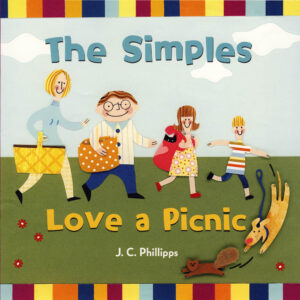 The Simples Love a Picnic
The Simples Love a Picnic
By J.C. Phillipps
Houghton Mifflin Harcourt
$16.99
ISBN: 978-0-544-16667-7
Ages 3-7
On shelves now
I am on a mission. A quest. A journey to find the funniest picture books published for children in a given year. It isn’t an easy thing to do. First, you have to deal with the sheer awe-inspiring number of picture books published these days. Then there’s the fact that funny is as funny does. What strikes me as friggin’ hilarious may not cause so much as a flick of the lips from you. This is probably why humor awards for children’s literature are few and far between. Then add in the fact that what kids find funny and what adults find funny is vastly different. If the very existence of knock knock jokes has taught us nothing it has taught us that. But you know . . . there are exceptions. I’ve seen kids and adults rolling in the aisles with a good reading of Bark, George by Jules Feiffer. I’ve seen adults laugh in honest surprise along with their kids when surprised by the events in Fortunately by Remy Charlip. And I bet your bottom dollar that if read correctly The Simples Love a Picnic by J.C. Phillipps could be one of those books a classroom of first graders fight to the death to check out from the library. The lie is in its very name: “Simple”. As a quick perusal shows, what Phillipps is able to accomplish here is anything but simplistic. After all, writing funny books is no easy task, yet The Simples Love a Picnic blows that notion right out of the water. Highly hilarious stuff.
It started off with an innocent enough suggestion. “Let’s have a picnic,” Dad proposes. The kids, Lulu and Ben, are unfamiliar with the concept, which is probably what prompts Lulu to pack a tub of ice cream amongst the supplies (her logic that “ice cream doesn’t spill” seems sound enough at the time). Off goes the family and after the occasional mishap (the dog chasing squirrels up trees, the cat appearing in Lulu’s backpack) they find themselves in the park. But locating the perfect location for a picnic turns out to be only slightly less hazardous than surviving what happens after the food comes out. In the end, the family finds the perfect place to devour a meal, though it isn’t where you might expect it to be.
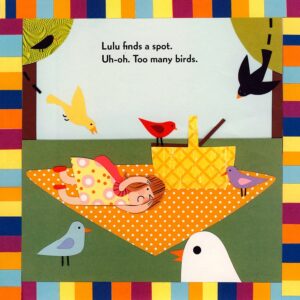 I can pinpoint the precise moment I fell in love with this book. I mean, sure I liked it from the get-go. Phillipps utilizes this cheery, upbeat can-do spirit that any child will tell you is just ASKING for trouble. And I was already pretty amused when son Ben started wondering what one eats at a picnic only to come up with a short list of what might be the worst picnic foods of all time (“Cereal?”, “Soup?”, etc.). And I could just hear myself reading this aloud to a group of kids when Rocco the dog went hell-for-leather for that squirrel up a tree (going the extra mile in turning Ben completely 180 degrees upside down). But really, it wasn’t until the picnic was underway that I went hook, line, and sinker for what Phillipps had conjured up. The family attempts to find a spot to have their picnic and Ben’s location turns out to have “Too many ants”. Pretty funny, but not as funny as Lulu’s spot. Now the sentence, “Too many birds” may not sound amusing, but suddenly Phillipps turns the scene into something out of an Alfred Hitchcock film. Lulu is seen clutching her head as, presumably, a bird dive bombs towards her, others calmly checking out the basket’s wares. This moment is echoed later when some melted ice cream sets off a kind of apocalyptic picnic frenzy of hoards of ants and even more dive-bombing birds (to say nothing of the squirrels). I’ve a weakness for any book that builds to a ridiculous climax and this one tapped into that feeling perfectly.
I can pinpoint the precise moment I fell in love with this book. I mean, sure I liked it from the get-go. Phillipps utilizes this cheery, upbeat can-do spirit that any child will tell you is just ASKING for trouble. And I was already pretty amused when son Ben started wondering what one eats at a picnic only to come up with a short list of what might be the worst picnic foods of all time (“Cereal?”, “Soup?”, etc.). And I could just hear myself reading this aloud to a group of kids when Rocco the dog went hell-for-leather for that squirrel up a tree (going the extra mile in turning Ben completely 180 degrees upside down). But really, it wasn’t until the picnic was underway that I went hook, line, and sinker for what Phillipps had conjured up. The family attempts to find a spot to have their picnic and Ben’s location turns out to have “Too many ants”. Pretty funny, but not as funny as Lulu’s spot. Now the sentence, “Too many birds” may not sound amusing, but suddenly Phillipps turns the scene into something out of an Alfred Hitchcock film. Lulu is seen clutching her head as, presumably, a bird dive bombs towards her, others calmly checking out the basket’s wares. This moment is echoed later when some melted ice cream sets off a kind of apocalyptic picnic frenzy of hoards of ants and even more dive-bombing birds (to say nothing of the squirrels). I’ve a weakness for any book that builds to a ridiculous climax and this one tapped into that feeling perfectly.
Phillipps isn’t exactly unknown to the world of funny picture books. It takes a very particular sort of brain to come up with titles like “Wink: The Ninja Who Wanted to be Noticed” (a book that was way into ninjas before the vast hoards of them published this year, by the way). From that book you got the very clear sense that Phillipps wasn’t just an author/illustrator to watch. She also was funny as all get out. Since that book’s release Ms. Phillipps has kept herself busy, but her books have always been big and bold. Ninjas and simians with names like Monkey Ono and the like. So part of what I admire so much about The Simples is that the book isn’t high-concept. On paper it doesn’t look like much: Family goes outside to picnic. Epic picnic fail. Family goes inside to picnic. Fin. Not much going on there. But what makes the book so great is that Phillipps is channeling great works of literature about seriously stupid people like The Stupids by Harry Allard and the Dumb Bunny books of Sue Denim. And in doing so, she manages to make something seriously smart.
I confess that I wonder if in this age of high self-esteem and fear of offense whether or not Allard’s books about the Stupids would be able to see the light of publication. Yet even as I say this I don’t mind the “simple” appellation Phillipps came up with here in the least. Yes, of course I’m aware of the term’s use historically as a sort of universal catchall for anyone mentally impaired. But taken in its modern context alongside the family featured here and it would take some pretty thin skin to find anything to object to. After all, this family isn’t really out-and-out dumb (though I have my worries about Ben). They just seem prone to awful decisions and bad luck. You could just as easily have named them The Schlimazels and probably would have been more accurate in the process (note to self: write picture book about The Family Schlimazel).
If the family’s actual name refers to anything then it’s probably the art style Phillipps chooses to utilize here. It utilizes the cut paper look that’s served her so well, but here she’s simplified it beyond her usual complexities. Of the family itself you’re pretty much lucky if you get so much as a line for your nose. Features are flattened, clothes cut and pasted. The result is not that a child could do this, but rather that a child could at least make an attempt at it. Yet for all that their eyes are mere dots in the head, Phillipps gets a lot of pathos and expression out of her little paper people. Whether it’s the turn of a mouth (comically upside down “u” shaped) to denote misery or the slant of an eyebrow over an eye, these people are pretty darn expressive. One should also note that Phillipps takes a page or two out of the graphic novelists’ handbooks when she splits her narratives on certain pages or makes use of distance and perspective. These people may be flat, but the storytelling never is.
This is the kind of book that tends to not get quite enough respect. It’s hardly the first picnic book in the world (love that Picnic by Emily Arnold McCully) but it may well be the most amusing. Between the psychotic birds and the suicidal squirrels there’s lots here to love. A great readaloud for groups and a hilarious romp overall, I am pleased as punch to designate this one of the funniest picture books of the year. Silly in all the right ways. Don’t miss it.
On shelves now.
Source: Galley sent from publisher for review.
Like This? Then Try:
Professional Reviews: Kirkus
Videos:
Yep! It has a trailer and everything.
And this one goes behind the scenes a bit. If nothing else, it shows us how cool it would be to live in Ms. Phillipps’ house.


By:
Betsy Bird,
on 3/8/2014
Blog:
A Fuse #8 Production
(
Login to Add to MyJacketFlap)
JacketFlap tags:
Schwartz & Wade,
Jenny Offill,
Best Books of 2014,
Reviews 2014,
2014 picture books,
2014 reviews,
Reviews,
picture books,
Best Books,
funny picture books,
Chris Appelhans,
Add a tag
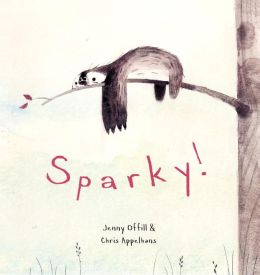 Sparky!
Sparky!
By Jenny Offill
Illustrated by Chris Appelhans
Schwartz & Wade (an imprint of Random House)
$16.99
ISBN: 978-0-375-87023-1
Ages 4-8
On shelves March 11th
The sloth is not a noble animal. Few people spend time contemplating their heroic qualities and distinguished countenances. Had I an Oxford English Dictionary on hand I’d be mighty interested to learn whether or not the term “sloth” as in “a habitual disinclination to exertion” was inspired by the tropical, slow-moving animal or if it was the other way around. Perhaps it is because of this that we don’t see them starring in too many picture books for kids. Sure you’ll get the occasional Lost Sloth by J. Otto Seibold, A Little Book of Sloth by Lucy Cooke, or even Slowly Slowly Slowly, Said the Sloth by Eric Carle, but unlike other animals there is no great slothian icon. When you say “sloth” to the average person on the street, they don’t instantly think of a famous one. Sparky! may come close to changing that. Tongue planted firmly in cheek, the sublime and subversive Jenny Offill pairs with first timer Chris Appelhans to give us a subdued but strangely content little tale about that most classic of all friendships: a girl and her sloth.
“You can have any pet you want as long as it doesn’t need to be walked or bathed or fed.” Our heroine’s mom probably regrets telling this to her daughter but it’s too late now. The minute she said it the girl headed straight to the library and there, in the S volume of the Animal Encyclopedia, she learned about sloths. In no time at all one appears via Express Mail and she names him Sparky (thereby giving away the fact that she harbors impossible sloth-related dreams). Her know-it-all neighbor Mary Potts is not impressed, so our heroine determines to show off her pet in a “Trained Sloth Extravaganza”. Naturally, this does not go as planned, but even after everyone has left and it’s just her and Sparky, she can’t help but love the little guy. With a quick tag to his claw she makes it clear that he is it. “And for a long, long time he was.”
 I was talking with some folks about picture books earlier today and in the course of our conversation I discovered something interesting about the way I judge them. While art is definitely something I take into account when I decide to love or loathe an illustrated work for kids, it’s the writing that always tips the balance. I’d read some of Offill’s picture books before and while I liked them fine they did not inspire in me the kind of rabid fan response I’ve seen other librarians profess thanks to 17 Things I’m Not Allowed to Do Anymore. Sparky! is different. Here, the book cuts to the chase right at the start. Our heroine (who remains unnamed throughout) makes it clear that her raison d’être is to have a pet. When Sparky arrives she pours herself into his care, never mind that he’s about as needy as a houseplant in this regard. There was something so enticing about her cheery demeanor, even in the face of cold hard facts. Her mother right from the get-go also has this world-weary air that suggests more than it tells. As for the repeated lines of “a promise is a promise”, it’s a line that clearly reflects our heroine’s worldview. The combination of wordplay and story definitely made this one of the more interesting picture books I’d seen in a while.
I was talking with some folks about picture books earlier today and in the course of our conversation I discovered something interesting about the way I judge them. While art is definitely something I take into account when I decide to love or loathe an illustrated work for kids, it’s the writing that always tips the balance. I’d read some of Offill’s picture books before and while I liked them fine they did not inspire in me the kind of rabid fan response I’ve seen other librarians profess thanks to 17 Things I’m Not Allowed to Do Anymore. Sparky! is different. Here, the book cuts to the chase right at the start. Our heroine (who remains unnamed throughout) makes it clear that her raison d’être is to have a pet. When Sparky arrives she pours herself into his care, never mind that he’s about as needy as a houseplant in this regard. There was something so enticing about her cheery demeanor, even in the face of cold hard facts. Her mother right from the get-go also has this world-weary air that suggests more than it tells. As for the repeated lines of “a promise is a promise”, it’s a line that clearly reflects our heroine’s worldview. The combination of wordplay and story definitely made this one of the more interesting picture books I’d seen in a while.
Illustrator Chris Appelhans comes to us from the world of animation, having worked on such films as Coraline and The Fantastic Mr. Fox. Comparisons to Jon Klassen, another animation escapee, are not entirely out of left field either. Like Klassen, Appelhans prefers a subdued style with a limited palette. He knows how to get a great deal of humor out of a character’s lack of movement and emotion. The sequence where the girl plays everything from King of the Mountain to Hide-and-Seek with Sparky would not work particularly well unless Appelhans utilized this technique. Add in the funny little story and I’m sure you’ll hear a lot of folks comparing this to Extra Yarn or something equally wry. That said, Appelhans is his own man. Emotion, for example, is something he alludes to beautifully. Note the bags of worry under Sparky’s eyes. I’ve never quite known what to call these, but they show up periodically in books and comics for kids. They’re great character reference points. The kind of bags that Charlie Brown would sport. Here, they suggest more about Sparky’s state of mind than anything else.
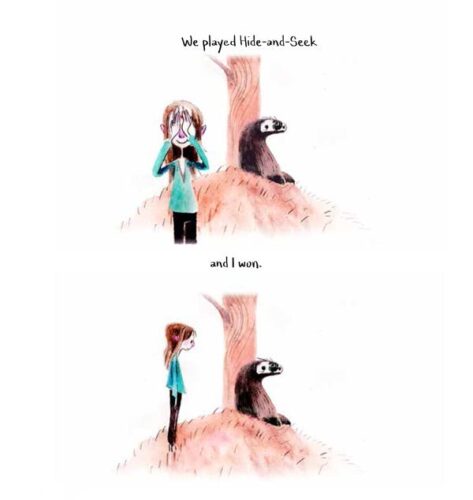 Note that Publishers Weekly was not charmed by Sparky! In fact, Publishers Weekly was pretty much bummed out by the whole experience of reading the book at all. Talking about it, they dowsed their review with words like “glum”, “lonely”, “miserable”, and (my personal favorite) “burdened with pathos”. A reading of this sort happens when you walk into the book expecting it to cater to your already existing expectations about what “pet” books should do. Where PW found the book depressing, I found it smart and serious. Yep, Sparky looks mildly perturbed for most of the book, but that’s only when he’s taken out of his natural environment. The very last image in the book of him finally getting to lie in his tree next to his girl is the only time we ever see him smile. As for the girl herself, she knows perfectly well what she got herself into and why her dream of getting him to perform fell through. And she’s a happier person than the seemingly self-assured Mary Potts, that’s for sure, having a fair amount in common with Calvin from Calvin & Hobbes. As such, this isn’t the downer fare you’d necessarily expect.
Note that Publishers Weekly was not charmed by Sparky! In fact, Publishers Weekly was pretty much bummed out by the whole experience of reading the book at all. Talking about it, they dowsed their review with words like “glum”, “lonely”, “miserable”, and (my personal favorite) “burdened with pathos”. A reading of this sort happens when you walk into the book expecting it to cater to your already existing expectations about what “pet” books should do. Where PW found the book depressing, I found it smart and serious. Yep, Sparky looks mildly perturbed for most of the book, but that’s only when he’s taken out of his natural environment. The very last image in the book of him finally getting to lie in his tree next to his girl is the only time we ever see him smile. As for the girl herself, she knows perfectly well what she got herself into and why her dream of getting him to perform fell through. And she’s a happier person than the seemingly self-assured Mary Potts, that’s for sure, having a fair amount in common with Calvin from Calvin & Hobbes. As such, this isn’t the downer fare you’d necessarily expect.
The School Library Journal review, for that matter, did a small bit of hand wringing over whether or not children would come away from this book with the clearly misbegotten understanding that having a sloth for a pet would be fun. Since this is a work of fiction (and the underground sloth procurement market remaining, for the most part, elusive to their needs) I hardly think we need fret about whether or not kids will take the wrong message away from Sparky! After all, it makes sloth ownership look just about as appealing as whale ownership in Billy Twitters and His Blue Whale Problem. Sparky is awfully cute but as our heroine is quick to learn, he’s not about to do much of anything he doesn’t want to do. The only time he does something the heroine suggests, it’s when he munches slowly on a cookie she’s offered him (and then proceeds to take back when it’s clear he’s going to take all day with it).
It’s a much quieter picture book than those full of glam and glitz, cluttering up our shelves. Like its color scheme Sparky! suggests that pet ownership is not a predictable path. Or maybe it’s saying that imposing your will on others, particularly the barely sentient, isn’t the way to go. Or maybe it’s just a funny book about a funny sloth. That works too. However you look at it, there’s no denying that though it’s a silly idea (telegraphed by the silly contrast between the title and explanation mark and the cover image) with a slow, steady feel and delightful premise. You read into the book what you want to read into it. For me, that means reading into it a great story with beautiful art (that final sunset is a doozy), and likable characters. What more need you in life?
On shelves March 11th
Source: Galley sent from publisher for review.
Like This? Then Try:
Professional Reviews:


By:
Betsy Bird,
on 1/31/2013
Blog:
A Fuse #8 Production
(
Login to Add to MyJacketFlap)
JacketFlap tags:
Reviews,
poetry,
Jack Prelutsky,
Harper Collins,
Best Books,
Greenwillow,
Carin Berger,
funny picture books,
funny poetry,
picture book poetry,
Best Books of 2013,
Reviews 2013,
2014 Caldecott Contender,
2013 funny books,
2013 poetry,
Add a tag
 Stardines Swim High Across the Sky and Other Poems
Stardines Swim High Across the Sky and Other Poems
By Jack Prelutsky
Illustrated by Carin Berger
Greenwillow Books (an imprint of Harper Collins)
$16.99
ISBN: 978-0-06-201464-1
Ages 4-8
On shelves February 26th.
To non-children’s librarians the statistics are baffling. Your average poetry book isn’t exactly a circ buster. It sits on the shelf for months at a time, gathering dust, biding its time. When kids come to the reference desk to ask for titles, they don’t tend to ask for poetry unless they’ve some sort of assignment they need to fulfill. Yet for all that poetry books for kids are shelf sitters, it’s hard to find a single one that hasn’t gone out in the last two or three months. How to account for it? Well, there’s Poetry Month (April) to begin with. That always leads to a run on the 811 portion of the library shelves. But beyond that kids read poetry in dribs and drabs over the course of the year. Maybe as Summer Reading books. Maybe as class assignments. Whatever the reason, poetry has a longevity, if not a popularity, that’s enviable. Now Jack Prelutsky, our first Children’s Poet Laureate and creator of Behold the Bold Umbrellaphant is following up his work with yet another delve into (in the words of Kirkus) “iambic ‘pun’tameter”. And while Prelutsky gives us a second round, illustrator Carin Berger steps up her game to give these hybrid birds and beasts a kick in the old artistic derriere.
 Forget everything you ever knew about animals. Not since On Beyond Zebra has the world seen a menagerie quite as wild as the one on display here. Step right up, folks, and take a gander at the rare and remarkable Fountain Lion. “The only lions no one dreads, / They all have fountains on their heads.” Delicious crustaceans more your speed? Then come and observe the rare Slobsters. “Their sense of decorum / Is woefully small. / Slobsters don’t have / Many manners at all.” Or for the kiddies, how about an adorable Planda? “They plan to learn to roller-skate, / To juggle, and to fence. / They plan to go to clown school / And cavort in circus tents.” With his customary clever verse, Jack Prelutsky invents sixteen imaginary animals of varying degrees of odd. Accompanying his rhymes is his old partner-in-crime Carin Berger, who has moved beyond mere collage and has gone so far to construct elaborate shadow boxes of each and every poem. The end result is impressive, hilarious, and one of the most original little poetry collections you’ll see in many a year.
Forget everything you ever knew about animals. Not since On Beyond Zebra has the world seen a menagerie quite as wild as the one on display here. Step right up, folks, and take a gander at the rare and remarkable Fountain Lion. “The only lions no one dreads, / They all have fountains on their heads.” Delicious crustaceans more your speed? Then come and observe the rare Slobsters. “Their sense of decorum / Is woefully small. / Slobsters don’t have / Many manners at all.” Or for the kiddies, how about an adorable Planda? “They plan to learn to roller-skate, / To juggle, and to fence. / They plan to go to clown school / And cavort in circus tents.” With his customary clever verse, Jack Prelutsky invents sixteen imaginary animals of varying degrees of odd. Accompanying his rhymes is his old partner-in-crime Carin Berger, who has moved beyond mere collage and has gone so far to construct elaborate shadow boxes of each and every poem. The end result is impressive, hilarious, and one of the most original little poetry collections you’ll see in many a year.
The shadow box, that staple of undergraduate art projects everywhere, is a relative newcomer to the world of children’s literature. A shadow box, once you’ve designed it and filled it with cool images, needs to be photographed perfectly if it’s going to work on a flat page. That means you need an illustrator confident in their abilities to produce art that will look as good in two dimensions as three. Berger is clearly up to the challenge. A master of collage, in this book she bends over backwards to make her images the best they can be. She’s very good at conveying distance. She also conveys perspective quite well. A cut image of a bicycle makes it appear to be three-dimensional because it is photographed from above. I know the image itself is just a flat piece of paper, but the illusion is complete. Everything, in fact, appears to have been planned with a meticulous eye.
Even within the boxes themselves Berger’s job is not easy. Consider an early poem called “Bluffaloes” which combines the word “Buffaloes” with the word “Bluff”. It’s about buffalo types who are scaredy cats should you call their bluff. Fair enough. Now how the heck do you illustrate that? In Berger’s case it looks like she may have considered an alternative definition of the word “bluff” as in “a cliff, headland, or hill with a broad, steep face” since her bluffaloes look like nothing so much as little pieces of a cliff running hither and thither on newly sprouted legs. Artistic creativity is much called for when wordplay is open ended.
 Of course, as an adult I’m going to be naturally inclined towards artsy fartsy styles. But this all begs the obvious question: Will kids dig it? Well, let’s stop and consider for a moment. What precisely has Berger done? She has made little boxes and put action-packed scenes within them. Who else does that kind of thing? If you said, “Kids who make dioramas for school” you have earned yourself a cookie. Yes, it appears to me that Berger has taken one of the oldest homework assignments of our age and has turned it into a book. An enterprising teacher would find a goldmine of assignment material here. What if they had their kids write their own poems in Prelutsky’s style? What if they made pairs of kids come up with the idea for the poem and then one kid could write it while the other made a diorama to go with it? Can you now say, “instantaneous original poetry project for Poetry Month”? I knew you could.
Of course, as an adult I’m going to be naturally inclined towards artsy fartsy styles. But this all begs the obvious question: Will kids dig it? Well, let’s stop and consider for a moment. What precisely has Berger done? She has made little boxes and put action-packed scenes within them. Who else does that kind of thing? If you said, “Kids who make dioramas for school” you have earned yourself a cookie. Yes, it appears to me that Berger has taken one of the oldest homework assignments of our age and has turned it into a book. An enterprising teacher would find a goldmine of assignment material here. What if they had their kids write their own poems in Prelutsky’s style? What if they made pairs of kids come up with the idea for the poem and then one kid could write it while the other made a diorama to go with it? Can you now say, “instantaneous original poetry project for Poetry Month”? I knew you could.
Then there’s Prelutsky. He always scans. He always rhymes. And he throws in big words that will give some children a good dictionary workout. For example, in the Sobcat poem he writes, “The SOBCAT is sad / As a feline can be / And spends its time crying / Continuously. / It has no real reason / To be so morose. / It’s simply its nature / To act lachrymose.” Nice. Of course the unspoken secret to many of these poems isn’t that they simply make clever pairings of words and phrases with animals but that they say something about certain types of people. The Planda makes eternal plans and never carries them out. The Sobcat “delights / In its own misery”. You can find many a friend and a relation found in the animals of these pages.
The pairings of the poems is sometimes key. It works particularly well when you place the “Jollyfish” poem next to the “Sobcat”, for example. There are other moments when you suspect that the layout and order of the poems was a carefully thought out process. The book begins, for example, with the titular poem “Stardines” which comments that “In silence, these nocturnal fish / Are set to grant the slightest wish.” That’s a good note to begin on. The book then alternates between animals with physical attributes that are their primary lure and animals with one-of-a-kind personality quirks. It’s interesting to see how all this ends with, of all the animals, the Bardvark. “BARDVARKS think they’re poets / And persist in writing rhyme. / Their words are uninspired / And a total waste of time.” So it is that book of poetry for kids ends by highlighting an animal that’s an atrocious poet. The final lines, “Undeterred, they keep on writing / And reciting every day. / That’s why BARDVARKS are a problem – / You can’t make them go away.” One can’t help but think Prelutsky is taking a little jab at himself here. Not a significant jab, but small enough to allow him to laugh at himself a little. Not a bad way to finish, really.
 Perhaps a key at the back of the book explaining which animals and concepts were combined would not have been out of place. I found myself baffled by the “swapitis” (pronounced swap-uh-teez) and found myself wishing I knew what animal it hailed from. It looks somewhat deer-like. After a bit of internet searching I discovered an animal called a wapitis, which is a kind of North American deer. Good to know, though I suspect it won’t immediately pop to many folks’ minds unless prompted and prodded a bit. Of course having kids find the animals referenced could be a fun homework assignment in and of itself. There are possibilities there. Just no answers.
Perhaps a key at the back of the book explaining which animals and concepts were combined would not have been out of place. I found myself baffled by the “swapitis” (pronounced swap-uh-teez) and found myself wishing I knew what animal it hailed from. It looks somewhat deer-like. After a bit of internet searching I discovered an animal called a wapitis, which is a kind of North American deer. Good to know, though I suspect it won’t immediately pop to many folks’ minds unless prompted and prodded a bit. Of course having kids find the animals referenced could be a fun homework assignment in and of itself. There are possibilities there. Just no answers.
Jack Prelutsky is a staple. Folks my age still associate him with The New Kid On the Block. Kids these days have a lot more Prelutskyian choices to pick from. Berger, in contrast, is new and fresh and bright and shiny. Combine the old school rhymes and chimes of a Prelutsky with the crackling energy and visual wit of Berger and you’ve got yourself a heckuva team. Stardines may tread familiar ground once trod before, but its method of presentation is anything but overdone. Hand this one to the kid who moans to you that they “have” to read a book of poetry for school. Who knows? It may hook ‘em before they realize what’s what. One of a kind.
On shelves February 26th.
Source: Galley sent from publisher for review.
Like This? Then Try:
- Wabi Sabi by Mark Reibstein, illustrated by Ed Young
Other Blog Reviews: Book Aunt
Professional Reviews:
Misc:
 Read this great little short interview with Ms. Berger at Seven Impossible Things Before Breakfast as she discusses how, “This seemed a perfect opportunity to reference my passion for wunderkammers and early science — and crusty old museums.”
Read this great little short interview with Ms. Berger at Seven Impossible Things Before Breakfast as she discusses how, “This seemed a perfect opportunity to reference my passion for wunderkammers and early science — and crusty old museums.”
- It’s Poetry Friday! Head on over to Teaching Authors to see the round-up of other great poetry books of the day!
Video:
Take a studio tour into the world of Carin Berger to see some of the fantastic art from this book.







By:
Betsy Bird,
on 1/24/2013
Blog:
A Fuse #8 Production
(
Login to Add to MyJacketFlap)
JacketFlap tags:
Best Books,
Best Books of 2013,
picture books,
Chronicle,
wordless picture books,
funny picture books,
lift-the-flap books,
Molly Idle,
Reviews 2013,
2013 funny books,
2013 picture books,
2013 reviews,
dance picture books,
Reviews,
Add a tag
 Flora and the Flamingo
Flora and the Flamingo
By Molly Idle
Chronicle Books
$16.99
ISBN: 978-1-4521-1006-6
Ages 3-7
On shelves February 3rd
Did you know that flamingos are pink because of their diet of plankton? Did you know that the flamingo is the national bird of the Bahamas? And did you know that when it comes to a pas de chat or a particularly fine jetée, no bird exceeds the flamingo in terms of balletic prowess? No? Then you’re clearly not reading the right literature these days. Now, before you get to thinking too hard about it, let me assure you that when I discuss a book like Flora and the Flamingo I should right off the bat say that this is NOT a book about a bird that wants to be a ballerina and must overcomes obstacles to achieve that goal. That is, without a doubt, the most common storyline in ballet picture books today. I would not review such a book as that. No, Flora and the Flamingo is notable because it is a perfect amalgamation of wordless storytelling, likable (or at least understandable) characters, and an artistic sensibility that will make you forget its unique formatting and remind you only of the classic picture book days of yore. So forget what flamingos eat. Are you getting enough flamingo picture books in YOUR diet? If not, time to start.
A single flamingo lands and perches on one leg beneath the falling pink blossoms. It does not notice the single flippered foot that appears behind it nor, at first, the bathing suited little girl that mimics his stance. But when he starts to stretch (or is he dancing?) he can’t help but see how she tries to imitate him, wing for wing. In a moment of cussidness he bleats at her, causing her to tumble head over heel into the water. Chastened, the flamingo offers a wing and the two embark on a fantastic dance, culminating in a joyous leap into the water and an elegant bow and curtsey.
Idle has the mark of the animator all over her. It’s a style of drawing you’ll find in the works of folks like Tony Fucile or Carter Goodrich. You can recognize an animator pretty easily right from the start. They tend to have very expressive protagonists. Take Flora, for example. Though at first she attempts to keep her face relatively placid, as the book goes on, a variety of emotions flit across her punim. From a miserable (mouthless) hurt glare to a skeptical raised eyebrow, to gentle trust, and, finally, pure pleasure. The white background sort of clinches it. Kirkus, in their review, said that there is a “courageous use of white space” in this book, and I have to agree. Yet for all that she has an animator’s heart, Idle avoids the pitfalls that have felled many from her field that have come before her. I’m talking about storyboarding. The laziest kind of picture book is the kind that feels like it began life as a serious of quick sketches tacked up on a wall somewhere. Storyboarding has its place in the world, but it is not an effective way to map out a picture book. There has to be a flow and a relationship between the pages. You have to know that by turning one you’re advancing the story right there. Idle achieves that feeling, and the reward is a tale that is as emotional as it is visual.
Idle does something particularly striking with the book that many an early 21st century reader might notice. Flora is certainly an everygirl, and in no way is that more evident than her weight. I am sorry to report that in the children’s book world, if a character is plus sized or larger than average, that will usually be the sole focus of their tale. The everyday adventures of kids that don’t look like walking popsicle sticks are nigh unto impossible to find sometimes. The nice thing about this book is that unless you want to interpret it as an exercise book (don’t) it isn’t about Flora’s pear-shaped body. Now if one were feeling somewhat cynical they might suspect that Idle is using her heroine’s weight to make her comical. I don’t think that’s really the case. Certainly the contrast between her and the flamingo is set off by their different appearances (more on that soon), but you could also argue that by giving her heroine a little more meat on her bones, Idle makes Flora easier to identify with. There are lots of overweight kids in America right now. Seems to me it shouldn’t be too hard to give them a happy dancing kid hero. Remember the “No Rain” by Blind Melon music video? It’s like that.
The unspoken (ha ha – there are no words in this book) irony here is the fact that flamingos are not usually considered unusually graceful birds. There’s a skinny gawkiness about them, and Idle makes use of that gawkiness to contrast her feathered hero with the very different awkwardness of the girl. Where he is all knobby knees and thin curled neck, she is circles and smiles. His elegant pink feet bear nothing in common with her ginormous brown flippers. This dichotomy is the striking difference that gives the book its visual kick in the pants. The white background and pink apple blossom-like flowers that frame the edges of the pages are perfectly suited to focus your attention on the bird and the girl. The flaps are just the icing on the cake.
 I probably should have mentioned it before, but Flora and the Flamingo is actually a lift-the-flap picture book. If you want a fun exercise in clever book design, read just the pages with the flaps. You’ll see that at first Flora’s flap and the flamingo’s are on opposite pages with the flamingo directly in the center of his page and Flora’s flap slightly closer to the flamingo’s page. Skip ahead and you’ll see that Flora has traversed the gutter (the area found between pages) and suddenly her flap is touching the flamingo’s (no wonder he gets tetchy!). After he hurts her feelings the flaps are as far from one another as they can be. The flamingo makes good and for the first time the two characters share a single, large flap. They dance and it all builds up to a gatefold in the book that can be opened to reveal the two cannonballing happily into the water. Beautifully done.
I probably should have mentioned it before, but Flora and the Flamingo is actually a lift-the-flap picture book. If you want a fun exercise in clever book design, read just the pages with the flaps. You’ll see that at first Flora’s flap and the flamingo’s are on opposite pages with the flamingo directly in the center of his page and Flora’s flap slightly closer to the flamingo’s page. Skip ahead and you’ll see that Flora has traversed the gutter (the area found between pages) and suddenly her flap is touching the flamingo’s (no wonder he gets tetchy!). After he hurts her feelings the flaps are as far from one another as they can be. The flamingo makes good and for the first time the two characters share a single, large flap. They dance and it all builds up to a gatefold in the book that can be opened to reveal the two cannonballing happily into the water. Beautifully done.
I could get a lot of good out of this book with kids, I can see it now. First up, it would pair amusingly with another make-a-flamingo-your-buddy book, You WILL Be My Friend! by Peter Brown. As a ballet book, this title is also rather excellent. You can actually name the steps from time to time. I suppose if you absolutely had to you could even argue for this as an exercise book, but that’s pushing it. At its heart, Flora and the Flamingo is just an unassuming little story about making a friend. There’s nothing very complicated about that idea. It’s just all in how you present it, baby. Consider this one book that’s not afraid to let clever (yet essentially simple) design and good art do the heavy lifting.
On shelves March 1st.
Source: Final copy sent from publisher for review.
Like This? Then Try:
Professional Reviews:
Misc:
Videos:
Lest you doubt me when I proclaim Idle’s Dreamworks cred . . .
Now see the flaps in action!






By:
Administrator,
on 5/7/2012
Blog:
Margo Dill's Read These Books and Use Them!
(
Login to Add to MyJacketFlap)
JacketFlap tags:
Picture Book,
Guardian Angel Publishing,
Reading Skills,
funny picture books,
Book Giveaway Contest,
Elementary Educators,
Personal Connections,
Preschool to 1st grade teachers,
Blog hop,
Rhyming Words,
National Children's Book Week,
Craig Lindsey,
Add a tag
 It’s National Children’s Book Week, a week to celebrate children’s books. There are no better! This week, I am taking part in a blog hop with other children’s bloggers from my publisher, Guardian Angel Publishing. (They are publishing one of my picture books, release date still to be determined.) Anyway, you can visit each blog this week for exceptional posts and a chance to win fabulous prizes! To enter, visit any of the blogs listed below and participate in the RAFFLECOPTER contest. If you’ve never done RAFFLECOPTER before, it is so easy–don’t be scared.
It’s National Children’s Book Week, a week to celebrate children’s books. There are no better! This week, I am taking part in a blog hop with other children’s bloggers from my publisher, Guardian Angel Publishing. (They are publishing one of my picture books, release date still to be determined.) Anyway, you can visit each blog this week for exceptional posts and a chance to win fabulous prizes! To enter, visit any of the blogs listed below and participate in the RAFFLECOPTER contest. If you’ve never done RAFFLECOPTER before, it is so easy–don’t be scared.  You just do each step and then click the + points button to get credit for it. It is really important that you give yourself credit because Rafflecopter is collecting all the entries for us from all the blogs. If you don’t push the button, you won’t get credit, and you can’t win the fabulous prizes.
You just do each step and then click the + points button to get credit for it. It is really important that you give yourself credit because Rafflecopter is collecting all the entries for us from all the blogs. If you don’t push the button, you won’t get credit, and you can’t win the fabulous prizes.
What are we giving away? (You can win either one.)
• One FREE Picture Book Manuscript Critique by Margot Finke
• One FREE tote bag of children’s books from the participating authors
Visit May 7-13, 2012 and automatically enter for a chance to win by commenting, become a GFC Follower, and/or become a Facebook fan or friend at each of the author blogs listed below.
Here’s who is participating:
Guardian Angel Publishing Author Blogs:
Mayra Calvani – www.mayrassecretbookcase.blogspot.com
Margo Dill – www.margodill.com/blog
Margot Finke – www.hookkidsonreading.blogspot.com
Donna McDine – www.donna-mcdine.blogspot.com
Nancy Stewart – www.nancystewartbooks.blogspot.com
Kai Strand – www.kaistrand.blogspot.com
Nicole Weaver – www.mysisterismybestfriend.blogspot.com
So visit these each day for a new entry!  You can win children’s books during CBW!
You can win children’s books during CBW!

I’d like to kick off this week by talking about a new favorite at our house–my toddler LOVES this book. She wasn’t so sure it was great when I first brought it home from the hospital, but. . .I won her over, and it is now almost as popular as Brown Bear, Brown Bear. SO, the title is Farmyard Beat by Lindsay Craig. It starts out with the chicks who have the beat. Peep! Peep! Peep! So, of course, they wake up. . .SHEEP. . .who also have the beat–and they wake up cat, and so on. Soon, Farmer Sue hears the racket, and she comes to investigate. But those chicks, they just can’t help themselves. This book is so catchy that I walk around the house now singing it. I have it practically memorized, and my daughter claps to the beat. I think it’s appropriate fo
By:
Administrator,
on 2/29/2012
Blog:
Margo Dill's Read These Books and Use Them!
(
Login to Add to MyJacketFlap)
JacketFlap tags:
funny picture books,
Elementary Educators,
six traits of writing,
Preschool to 1st grade teachers,
Shared Writing,
Writing Skills,
6 +1 traits of writing,
6 + 1 traits,
Mayer Mercer,
Picture Book,
wordless picture book,
Add a tag
 Today we are talking about the new, pretty-much WORDLESS, book from Mercer Mayer. But don’t forget to enter the giveaway for Meredith Zeitlin’s YA book Freshman Year and Other Unnatural Disasters and check out her book trailer here.
Today we are talking about the new, pretty-much WORDLESS, book from Mercer Mayer. But don’t forget to enter the giveaway for Meredith Zeitlin’s YA book Freshman Year and Other Unnatural Disasters and check out her book trailer here.
Now. . .Octopus Soup
*Picture book for preschoolers through third graders (really any level if you see my activities)
*A poor little octopus as the main character
*Rating: I love wordless books for all the opportunities they provide. My 16-month-old daughter sat STILL while I shared these illustrations with her and told her what was going on! Octopus Soup is a winner!
Short, short summary:
Told like a comic book strip with no words, this is the story of a little octopus who goes on an adventure by hitching a ride on a fishing boat. He winds up in a restaurant where the chef starts thinking, OCTOPUS SOUP! This causes a major chase through the streets to the dock, where the chef THINKS he has his octopus. But luckily the little guy has law enforcement on his side! When the octopus gets back into the ocean, his parents are super happy!
So what do I do with this book?
1. VOICE– You can do so many 6 + 1 traits of writing activities with this book. You can do VOICE. Let students write and give the characters a voice. What is the little octopus thinking/saying? How about the chef? What about the parents in the end? How about the lady shopping for melons? And so on. Students can write in paragraph or sentence form depending on their age. They can even write dialogue and practice punctuation.
2. WORD CHOICE–pick a page and tell what is going on. Concentrate on word choice when writing descriptions or even emotions of the characters. The students can use ANY WORDS THEY WANT because the story is there, but Mercer Mayer hasn’t put any words in their head yet (except maybe the ones in the illustrations!) Challenge students to come up with different words to describe the octopus, the soup, the ocean, and so on.
3. SENTENCE FLUENCY–Again, since there are no words, students (in shared writing or on their own) can write the story. Work on telling the story with sentences that start different ways or are varying lengths. This is the PERFECT sentence fluency, 6 + 1 traits lesson!
By:
Administrator,
on 1/29/2012
Blog:
Margo Dill's Read These Books and Use Them!
(
Login to Add to MyJacketFlap)
JacketFlap tags:
books about love,
McCarty Peter,
Picture Book,
Reading Skills,
funny picture books,
Valentine's Day books,
Elementary Educators,
Making Personal Connections,
Personal Connections,
Preschool to 1st grade teachers,
Shared Writing,
Add a tag

Madagascar by Aleix Cabarrocas Garcia www.flickr.com
I am including a photo of Madagascar on my blog today because I want to tell you about the commitment I made at church today. I want to post about it on my blog 1. to hold me accountable and 2. to inspire anyone else to do the same.  At church, a priest from the Christian Foundation for Children and Aging spoke about sponsoring children and elderly from around the world for $1.00 a day. He said that over 94 cents goes to the sponsored child, which is a great amount compared to the amounts that some charities take for administrative staff.
At church, a priest from the Christian Foundation for Children and Aging spoke about sponsoring children and elderly from around the world for $1.00 a day. He said that over 94 cents goes to the sponsored child, which is a great amount compared to the amounts that some charities take for administrative staff.
Anyway, we’ve all heard stories like this before or seen commercials on TV. Many times, we do nothing–I’ve never sponsored anyone before. So, what made me change my mind this time. My daughter? My yearning to do something for people since I read HALF THE SKY? I’m not sure. But I was sitting there thinking about how much money we spent on a birthday dinner the night before, and I felt ashamed. If I can spend that much on one dinner (for a good friend, so it’s not totally selfish, right?), then I can surely give $1.00 a day to change somebody’s life. If I can stop spending $2.50 on a coffee and $2.25 on ONE PIECE OF COFFEE CAKE three times a week, I have my $30 a month easily. If I can eat lunch at home once instead of eating out. .. you get the picture.
So, my family is sponsoring Razafimamonjy from Madagascar. She is 5-years-old. Her mother does other people’s laundry for money. Razafimamonjy has syphilis. The family’s rent is $3.00 a month. Their walls are made of clay; their roof is tin; their floor is cement. They have NO indoor plumbing and get water from an outdoor pump. They sleep on the ground and cook with charcoal. I could go on. I won’t.
I am going to keep you updated on how I do with my STOPPING the Starbucks/Panera Bread coffee habit and giving my money to Razafimamonjy. If you want to join me, go to this website: http://www.hopeforafamily.org. They are legit. And let me know. It would be a great service learning project or family project for Lent. We can support each other while we are supporting people less fortunate.
I promised a picture book post today too, but I’m already going on and on. So, here’s a brief one:
Henry in Love by Peter McCarty
Henry is a cat in love with a bunny named Chloe. However, they are in elementary school. Therefore, Henry does crazy stuff like a forward roll in front of Chloe. She then shows him up by doing a cartwheel. In a twist of fate, the teacher moves Chloe and Henry to sit by each other, in time for snack. Henry has been saving his favorite snack all day–a blueberry muffin. But you know young love. . .he gives it to Chloe. Cute book. I enjoyed it. One reviewer on Amazon said she thought the love message was too subtle for kids to get–I see her point, but it’s still a cute book.
We are all starting to think about love around February. A cute gift for your child would be a copy of Henry in Love and some blueberry muffins. A fun Valentine’s Day activity for home school and/or the classroom would be to share this book with young readers and then together bake some blueberry muffins. You could also write poems/nice letters on p
By:
Administrator,
on 1/22/2012
Blog:
Margo Dill's Read These Books and Use Them!
(
Login to Add to MyJacketFlap)
JacketFlap tags:
Reading Skills,
funny picture books,
Creative Writing activities,
Elementary Educators,
Making Predictions,
six traits of writing,
Personal Connections,
Preschool to 1st grade teachers,
Shared Writing,
Watt Melanie,
story elements,
parts of a story,
Picture Book,
illustrations,
Add a tag

*Picture book for preschoolers through second graders
*A creative cat as the main character
*Rating: Chester is such a great illustrator and author–who needs that Melanie Watt? If you haven’t read any of the Chester the cat series of books yet (with NO HELP FROM Melanie), then you must check one out. So cute and funny!
Short, short summary: Chester the cat has hidden his owner’s, author and illustrator Melanie Watt’s, supplies and has taken over the creation of the book with his red pen. Chester is trying to write a masterpiece. First he steals from Twas the Night Before Christmas, and then he goes through a series of exercises to break his writer’s block. Once he’s ready, he writes some stories about himself and mouse–always ending unhappily with something tragic happening to mouse! In the end, Melanie finds her art supplies in a terrible hiding spot. . .Kids and adults will get a kick out of this hysterical picture book.
So what do I do with this book?
1. This is such a cute book. I love how “Melanie Watt” leaves editorial notes to Chester on “yellow Post-it notes.” Children will LOVE this book, and they will love to leave their own notes to Chester. While reading it, let them have some stickee notes and they can jot a few things down to Chester about his illustrations, his stories, etc.
2. This book has a lot of reading lessons in it. For example, Melanie tells Chester he needs a setting. They both draw a jungle. She asks what type of story he plans to write, and he goes through several genres like humor, action, and romance. They talk about endings, problems, and characters. It is full of things writers need to think about and address when writing a story. You can start a discussion with your class on these topics, using Chester and his masterpiece as a starting point.
3. For fun, let children try to guess where Chester hid Melanie’s art supplies. See if anyone is correct by the end of the book! 
By:
Administrator,
on 12/7/2011
Blog:
Margo Dill's Read These Books and Use Them!
(
Login to Add to MyJacketFlap)
JacketFlap tags:
Creative Writing activities,
Elementary Educators,
six traits of writing,
Personal Connections,
Preschool to 1st grade teachers,
Shared Writing,
6 +1 traits of writing,
picture books about dogs,
Stevens Janet,
picture books about cats,
Picture Book,
letter writing,
funny picture books,
Add a tag

If you haven’t visited my picture book giveaway yet for Chickens on the GO!, please do so now. You don’t want to miss this SUPER CUTE picture book. Click here.
Now on to this FUNNY, FUNNY picture book that dog owners EVERYWHERE have to check out–this is another one of those picture books that are perfect for any age reader.
*Picture book, preschooler through third grader, fantasy–since the dogs and cats are writing letters 
*Loveable dog and not-so-loveable cat as main characters
*Rating: If you love Dear Abby or any of the self-help talk shows, you will love Mr. Mutt. He solves all the dogs’ dilemmas. See if you recognize any of these going on in your home with your poor, mistreated dogs. . . (I love this book!)
Short, short summary:
Mr. Mutt accepts letters from all his dog fans, and they write him with the most common dog dilemmas of the day. For example, there’s “Famished in Florida” whose people have put him on a diet! He is so hungry his stomach is growling louder than he growls, and he also complains that the fat cat gets fancy food from a tiny can, while he gets tasteless gravel from a giant sack! Mr. Mutt sympathizes with Famished and explains to him where he can get some food–on the counter tops, the trash can, the baby’s high chair (MY DOG HAS LEARNED THAT FOR SURE!), and to top off the meal–a drink from the toilet. Then Mr. Mutt reminds Famished he is a top dog and that cats are spoiled rotten. Of course, Mr. Mutt has a cat to deal with himself, the Queen, and she writes her own opinions down.
Help Me, Mr. Mutt continues in this fashion with dogs writing letters full of problems to Mr. Mutt, and he answers them back with the best dog advice, and The Queen cat also gives her two cents. It is so cute and funny, and I really think adults will get a huge kick out of it, too.
So, what do I do with this book?
1. Kids will love writing a letter to Mr. Mutt–especially if Mr. Mutt can answer them back!  They can either write as a dog OR write as a human with a pet question. Kids would enjoy getting a letter back from The Queen, too. One huge classroom letter would do.
They can either write as a dog OR write as a human with a pet question. Kids would enjoy getting a letter back from The Queen, too. One huge classroom letter would do. 
2. The end of the book is told in mostly illustrations and “newspaper” clippings. The rest of the book is told in letter form with help from the illustrations. This is a form of organization, one of the 6 + 1 traits of writing. What do kids think about the organization? Can they tell the end of the story, even though it is not traditionally told with words? Also discuss with students how picture books have much of the story in illustrations, too, and how it is important to pay attention to both the words and pictures in a picture book. (Another part of the organization is there is an overall problem–the cat/dog dilemma, and then several little problems with the individual letters.)
3. If you have to teach parts of a letter or letter writing, what a great book to do it with. It’s much more fun to learn about letter writing from a humorous picture book like Help Me, Mr. Mutt than it is from a Language Arts textbook.
By:
Administrator,
on 11/13/2011
Blog:
Margo Dill's Read These Books and Use Them!
(
Login to Add to MyJacketFlap)
JacketFlap tags:
rhyming picture book,
Reading Skills,
funny picture books,
Creative Writing activities,
Elementary Educators,
Making Personal Connections,
Personal Connections,
Preschool to 1st grade teachers,
Shared Writing,
Rhyming Words,
shared writing activities,
silly picture books,
Picture Book,
Add a tag

*Picture book, preschool through 2nd grade
* A silly goose as the main character
*Rating: Silly Tilly is my kind of picture book. It is filled with all sorts of fun and rhymes and vibrant illustrations.
Short, short summary:
Silly Tilly is a very silly goose. For example, she takes a bath in apple juice. She took a nap in scarecrow’s pants and packed Piglet off to France. And the other barnyard animals are just plain tired of her silliness. She stops her antics, and then Hetta Hen realizes she hasn’t laughed since Silly Tilly did something silly. So, the animals apologize, and we get to see our lovable goose right back at her silliness.
So, what do I do with this book?
1. You cannot ignore the rhyme in Silly Tilly. Before reading, ask students to raise their hands if they hear any rhyming words. Ask them to remember at least a pair and tell it to you to write on chart paper when the story is over. Students/children can brainstorm more words that rhyme with the ones in the book. For an “advanced” discussion, what is Eileen Spinelli’s rhyme scheme?
2. When Silly Tilly changes whom she is for her friends, everyone suffers. No one is happy. This is a pretty deep concept for kids to understand, but oh so important. Use the characters in this silly book to get kids to see how important it is for each of them to 1. be themselves and embrace their uniqueness and 2. not expect other people, especially their friends, to change to please them.
3. Kids will have SO MUCH FUN making up their own silly things that Silly Tilly can do on the farm. You can either help them with the rhyming words or just do it with creativity–not worrying about the rhyme. Students can write down one of the silly things and illustrate it. Put these together in a class book–a Silly Tilly sequel.
By:
Administrator,
on 11/9/2011
Blog:
Margo Dill's Read These Books and Use Them!
(
Login to Add to MyJacketFlap)
JacketFlap tags:
Picture Book,
Reading Skills,
funny picture books,
Elementary Educators,
Books with Science Content,
Making Personal Connections,
Personal Connections,
Preschool to 1st grade teachers,
Prediction Skills,
French Jackie,
Add a tag

*Picture book for preschoolers through first graders
*Baby wombat as the main character
*Rating: Another cute book by Jackie French, who wrote, Diary of a Wombat too.
Short, short summary:
When baby wombat is finally finished sleeping, he goes out to play. He finds a friend–a baby human. Soon mother decides they need a bigger hole, and baby tries to problem solve. Eventually their little friend finds that bigger hole. Told in a cute style, such as: Later morning: Ate. Afternoon: Slept.
So, what do I do with this book?
1. If your students/children don’t know what a wombat is, then talk about this and also read them DIARY OF A WOMBAT. You can do a K-W-L chart before reading this book–what do you know about wombats? What do you wonder about them? And then when you are finished reading, what did you learn about wombats?
2. Let students keep a diary of their week. What I like about this book is it makes it look so easy to keep a diary/journal. You don’t have to have large, flowing paragraphs. You can just write: Morning: got on bus, talked to best friend. Got to school, turned in homework, picked as line leader. etc. Students can even include illustrations as part of the journal.
3. Students/children can work on their prediction skills with this book. You can do a day-by-day prediction, such as: “What do you think the wombat will be doing tomorrow morning?” You can also do a prediction when they are digging the big hole. Where are the wombats going to end up at the end of the book? Students should use the illustrations as a guide to help them figure out where the wombats are going to end up.
.jpeg?picon=3103)
By: Jenny Miller,
on 11/1/2011
Blog:
Where The Best Books Are!
(
Login to Add to MyJacketFlap)
JacketFlap tags:
Steve Jobs,
Margaret Wise Brown,
mommy bloggers,
funny picture books,
2011,
parody of Goodnight Moon,
Goodnight iPad,
Ann Droyd,
David Milgram,
books about kids and electronics,
best bedtime story of year,
Add a tag
Written & illustrated by Ann Droyd
$14.95, All ages, 30 pages
It seems like only yesterday that Margaret Wise Brown's bunny fell asleep saying nighty night to the moon.
Now all sorts of things are glowing in his house -- iPads, WiFi, Nooks -- and the last thing Bunny wants to do is tell them goodnight.
In fact, no one in his family wants to wish their devices goodnight -- well, except Granny. She hasn't warmed up to electronics (at least not that she realizes).
It looks like Granny will just have say all of their goodnights for them -- and give those glowy things the sendoff she thinks they deserve.
In this hysterical parody of Brown's Goodnight Moon, David Milgram (aka "Ann Droyd") shows an old-fashioned gal getting her digital family to bed by hurling all of its distractions out the window.
The result is a bedtime gem for the digital age that underscores how hard it is to tear kids and parents away from gadgets -- made all the more funny juxtaposed with Brown's sweet 1947 poem.
Coming out just weeks after the passing of Apple Founder Steve Jobs,
Goodnight iPad feels like a tribute and reminds us how much the iPad and all the devices Jobs created changed how we live -- and go to bed.
In Brown's classic, the bunny wishes goodnight to everything around his room. Then as the sky slowly deepens and he says goodnight to the moon, his eyes slip shut and he drifts off to sleep.
But in Milgram's spoof, the bunny and most of his family are too fixated on their electronic devices to realize it's bedtime.
The sky is already dark. The kids are in pajamas and everyone's clicking away in the family room.
0 Comments on Goodnight iPad as of 1/1/1900

*Picture book for all ages
*Donkey and Monkey as main characters
*Rating: This book had me laughing out loud from the first page. I disagree with many adults who say it’s not for kids. I think kids will get it–especially older elementary who still love picture books. It’s a Book by Lane Smith is a hit!
Short, short summary:
Monkey is reading a book–a real, live book–like one you check out from the library! Donkey can’t believe you don’t need to charge it or scroll down to read it. It has no social networking capabilities. You just open it and read it. Lane Smith has written a clever, clever book that speaks to what many people worry about will happen with the popularity of e-readers–we’ll forget what it’s like to hold a real book in our hands and enjoy it. (With young kids (preschool to first grade), you may have to explain some of the technology terms in the book to them.) WARNING: To all adults and parents: you should read this book from cover to cover to see if it is okay for you and your child or classroom. Instead of donkey, the word “jackass” is used. I don’t want to reveal how because it will ruin the great and funny surprise. I was laughing out loud. I would read this to my child, but I understand why some teachers may not be able to. I think it is a great play on words.

So, just read it first.
So, what do I do with this book?
1. Compare and contrast (you can even use a Venn diagram) an e-book to a hardcover book. Once you have this comparison, discuss the advantages and disadvantages of both forms.
2. For older kids whom you want to read this to and have fun!, ask them to write a persuasive paragraph on which is better–an e-book or a hardcover/paperback book. You could actually do this with younger kids, too, as a shared writing experience.
3. The illustrations in this book tell a lot of the story, especially on the pages where Donkey is reading the book. Study these illustrations and talk about how they help tell the story. Then have students draw a picture that tells a story–they can use a few words, but not many.
By:
Administrator,
on 2/14/2011
Blog:
Margo Dill's Read These Books and Use Them!
(
Login to Add to MyJacketFlap)
JacketFlap tags:
Picture Book,
Young Adult Novels,
funny picture books,
Elementary Educators,
Making Personal Connections,
Personal Connections,
Preschool to 1st grade teachers,
Shared Writing,
Books with Health Content,
picture books for preschool kids,
Diesen Deborah,
books about feelings,
Add a tag

*Picture book for preschoolers through first graders
*Young male fish as main character
*Rating: The Pout-Pout Fish will soon become one of your family’s or classroom’s favorites. Perfect for Valentine’s Day, too!
Short, short summary:
The pout-pout fish has a pout-pout face and is always down in the dumps in the ocean. Several happy sea creatures come by to offer some positive words of wisdom, so Mr. Fish will turn that frown upside down. But each time he explains that he is a pout-pout fish and he spreads the “dreary-wearies.” Readers will think there is no hope for Mr. Fish until a silent silver shimmer fish comes by and gives Mr. Fish a big old SMOOCH! This turns the pout-pout fish into a kiss-kiss fish!
So what do I do with this book?
1. This is a great book to talk about emotions and feelings! Why is Mr. Fish pouting? Is he sad or just stuck in a rut? Children can compare themselves to the creatures in the book and talk about when they’ve felt similar ways.
2. Have fun reading this book aloud! Do some echo reading–maybe even let children pretend to be different parts from the book–almost like reader’s theatre.
3. Pictures tell a lot of this story. Challenge students to tell a short story using only illustrations. Partner students up and have them trade their picture stories with each other.
Tune in Thursday for a picture book giveaway about a mouse violinist!
By:
Administrator,
on 2/10/2011
Blog:
Margo Dill's Read These Books and Use Them!
(
Login to Add to MyJacketFlap)
JacketFlap tags:
Arnold Tedd,
picture books about health,
Picture Book,
Tedd Arnold,
rhyming picture book,
funny picture books,
Creative Writing activities,
Elementary Educators,
Books with Science Content,
Making Personal Connections,
Personal Connections,
Preschool to 1st grade teachers,
picture book activities,
Rhyming Words,
Books with Health Content,
Parts,
Add a tag

*Funny, realistic picture book for preschoolers through first graders
*Preschool boy as main character
*Rating: Parts by Tedd Arnold can easily become your favorite book–as a kid and as an adult.
Short, short summary:
This poor boy thinks the glue that is holding him together is not working. He find pieces of hair in his comb. Something fell out of his nose, and he is sure it is his brain. Then there’s the skin on the bottom of his foot, and the last straw–his teeth–how will he eat? He gets some masking tape to try to hold himself together; but finally, his parents remember to tell him that this is a normal part of growing up!
So, what do I do with this book?
1. The first time you read it to children see if they think something is really wrong with him or if this is just the body’s way of growing. Ask children if these similar things have happened to them, and give them a chance to tell their stories (so allow for some extra discussion time when reading this book aloud!).
2. We all know at the end of the book that the boy has found ear wax, but can your students make a creative story about what he really found in his ear? For preschoolers, you can do this as a shared writing activity and each student can draw their own illustration. For first graders, they can write a short ending to the story. Encourage them to be creative with what the boy found in his ear! 
3. Use this book in a health unit to talk to students about what is really holding our body together–bone, muscles, skin, blood vessels, etc. etc. For younger students (such as two or three-year-old kids), you can talk about the parts they can see!
By:
Administrator,
on 2/7/2011
Blog:
Margo Dill's Read These Books and Use Them!
(
Login to Add to MyJacketFlap)
JacketFlap tags:
Lisa Wheeler,
Reading Skills,
funny picture books,
Elementary Educators,
Personal Connections,
Preschool to 1st grade teachers,
Rhyming Words,
picture books for preschoolers,
Books with Math Content,
Wheeler Lisa,
Picture Book,
Add a tag
 *Picture book for preschoolers through second graders
*Picture book for preschoolers through second graders
*Bear as main character
*Rating: Ugly Pie is the ideal picture book–cute story, wonderful illustrations and a takeaway activity.
Short, short summary:
Ol’ Bear is hankerin’ for Ugly Pie, but he doesn’t have all the ingredients. All he has is some molasses. So, he goes out looking for Ugly Pie. As he comes to each of his friends, they offer him a kind of pie, but Ol’ Bear really wants that Ugly Pie. They do give him some ingredients each time; and by the time he gets home, he can make his Ugly Pie. He sings a cute rhyme each time, too: “My-oh-my! But I’m still itchin’ for some Ugly Pie.” The very end of the book is a recipe for all the little cubs out there who are hankerin’ for Ugly Pie.
So, what do I do with this book?
1. Obviously, kids will want to make the recipe just like Ol’ Bear, but bring some math instruction into it. For advanced students, you can ask them to double or half the recipe. For some students, they just need practice with reading a recipe or even following directions. Look over your objectives you need to teach (at home schools, too) and use this as a fun activity and lesson!
2. Ask students to write about a time they were “hankerin’” for something and what they did to get it!
3. Word choice (one of the six plus one traits of writing) is very strong in Lisa Wheeler’s Ugly Pie from the playful use of language on the first page to the little rhyme Bear sings throughout. Ask students to pick a “favorite” word to tell you when they hear you read it aloud. Make a list on chart paper of these favorite words. Hang in the room for students to use in their own writing. (Personally, my favorite word is “hankerin’”.)
By:
Administrator,
on 1/20/2011
Blog:
Margo Dill's Read These Books and Use Them!
(
Login to Add to MyJacketFlap)
JacketFlap tags:
Elementary Educators,
six traits of writing,
Preschool to 1st grade teachers,
Fractured Tall Tales and Fairy Tales,
Books with Health Content,
Picture Book,
Edgar Allan Poe,
Adjectives,
Reading Skills,
funny picture books,
Add a tag

*Fiction picture book for preschool to third graders
*3 boys as main characters
*Rating: Edgar, Allan, and Poe and the Tell-Tale Beets is a cute take on Edgar Allan Poe’s scary story, “Tell-Tale Heart.”
Short, short summary:
Edgar, Allan, and Poe are brothers who aren’t crazy about their mom’s cooking. Well, who would be when she serves things like beets and liver? But they do love her dessert. The problem is they can’t get any dessert until they finish all their dinner, and that’s impossible until. . .they discover the loose floorboard. The brothers decide to cause a distraction and then put the disgusting food in the floorboard. The plan works perfectly, and they get to eat all kinds of delicious dessert until . . .they start hearing
Beet. Beet. Liver. Liver. And the smell! The food stinks under the floor board, and finally, they confess everything they’ve been doing right before a huge explosion occurs.
So, what do I do with this book?
1. You can use this book when also studying nutrition. Talk to students and children about why the boys’ mother was making and serving this food. Discuss alternative healthy foods she could serve. For example, what could she serve instead of liver or beets that have the same vitamins but are tastier? Ask students to write a letter to the mother and suggest these alternative foods.
2. Natalie Rompella does a great job with word choice in this book. There are tons of description words and strong action verbs. Make a list of the strong word choices in this book and post it on the wall. Point it out to students when they are busy writing.
3. Older primary students would be able to learn about Edgar Allan Poe and some of his work. Then talk to students about how this version is similar and different from “Tell-Tale Heart.”
View Next 3 Posts
 Every single list that appears on this blog is subjective. I mean, here I am declaring stuff to be great based entirely on a single solitary opinion: my own. That’s okay when you’re talking alphabet books or readalouds, but humor is a far trickier matter. There are a LOT of humorous picture books that come out in a single year and this list is just a miniscule smattering of the whole. That said, these are the books that really retained a strong grip on my brain after reading them. There were other funny books out in 2016. I’m just particularly partial to the following. I’m pleased with the number of funny women representing here too. After all, if there’s one thing I know something about, it’s funny girls.
Every single list that appears on this blog is subjective. I mean, here I am declaring stuff to be great based entirely on a single solitary opinion: my own. That’s okay when you’re talking alphabet books or readalouds, but humor is a far trickier matter. There are a LOT of humorous picture books that come out in a single year and this list is just a miniscule smattering of the whole. That said, these are the books that really retained a strong grip on my brain after reading them. There were other funny books out in 2016. I’m just particularly partial to the following. I’m pleased with the number of funny women representing here too. After all, if there’s one thing I know something about, it’s funny girls.


































































Yahoopy! I adore Best Frints in the Whole Universe and so do my 6-year-old and 3-year-old boys.
Fun thing to do: read a kid the book and then ask them whether Yelfred and Omek are boys or girls. I love that the book never lets on one way or another.
Thank you so much for these lists! It’s making every morning extra special!
The tree frog gag is hilarious. Thank you for that. And for everything else.
Love the lists! Thank you.
Thanks for all the great recs! I loved A Hungry Lion & Leave Me Alone. Very curious about Next to You, since it doesn’t have a typical funny-looking cover.
That’s part of its allure.
If my 2-year-old was picking the best book of the year it would be Poor Little Guy. It’s his favorite book and he keeps requesting it from the library. He loves it and he thinks it’s so funny. One of my favorites of the year too.
I’m also so glad to see someone else you loves Super Happy Magic Forest. So much for fantasy fans and geeky parents and their kids. I love all the many various side comments and speech bubbles. It has so much going on it’s a delight to read!
How did you know I needed a laugh? Thanks for this list and inspiring me to write a funny book of my own!